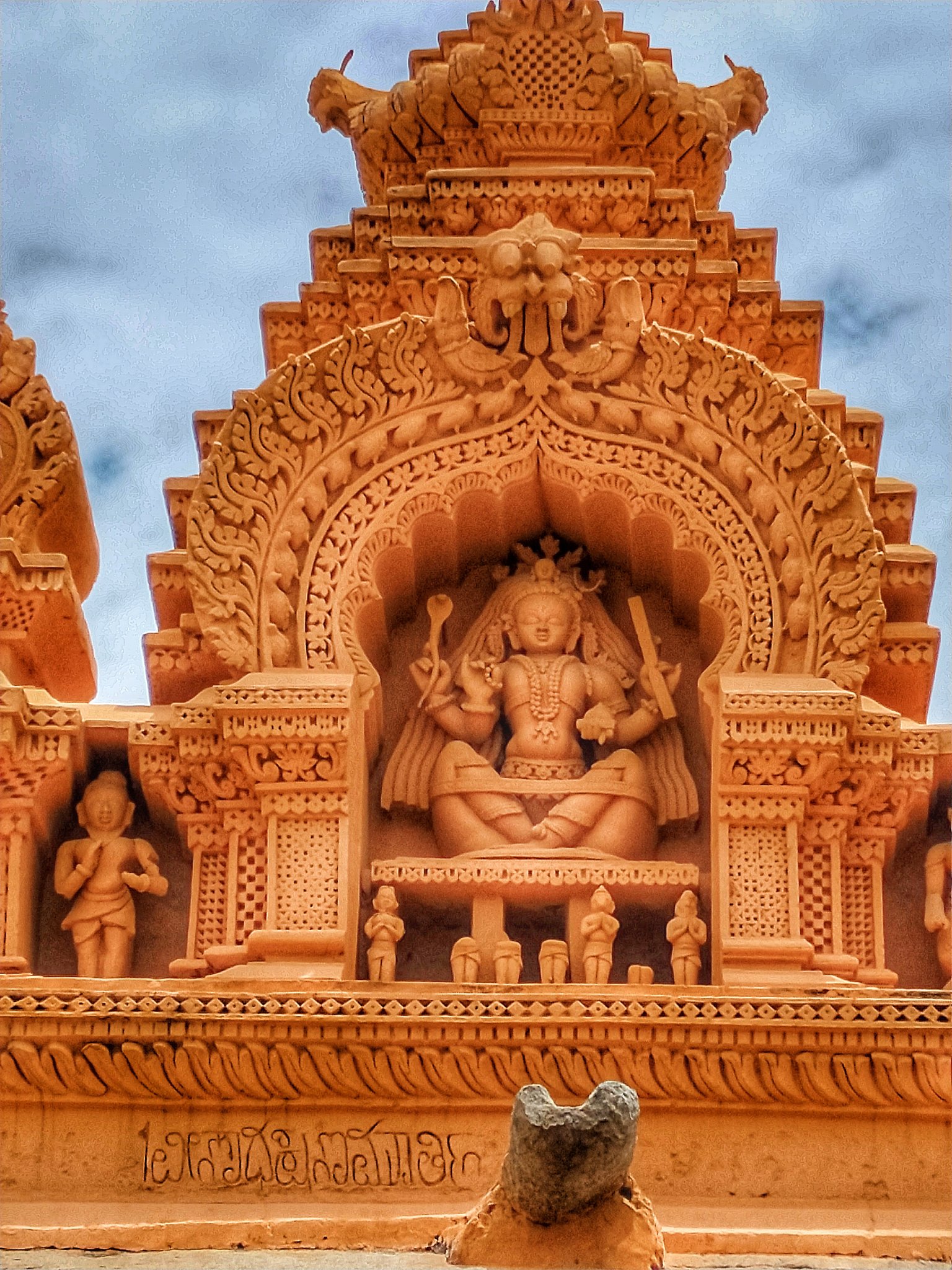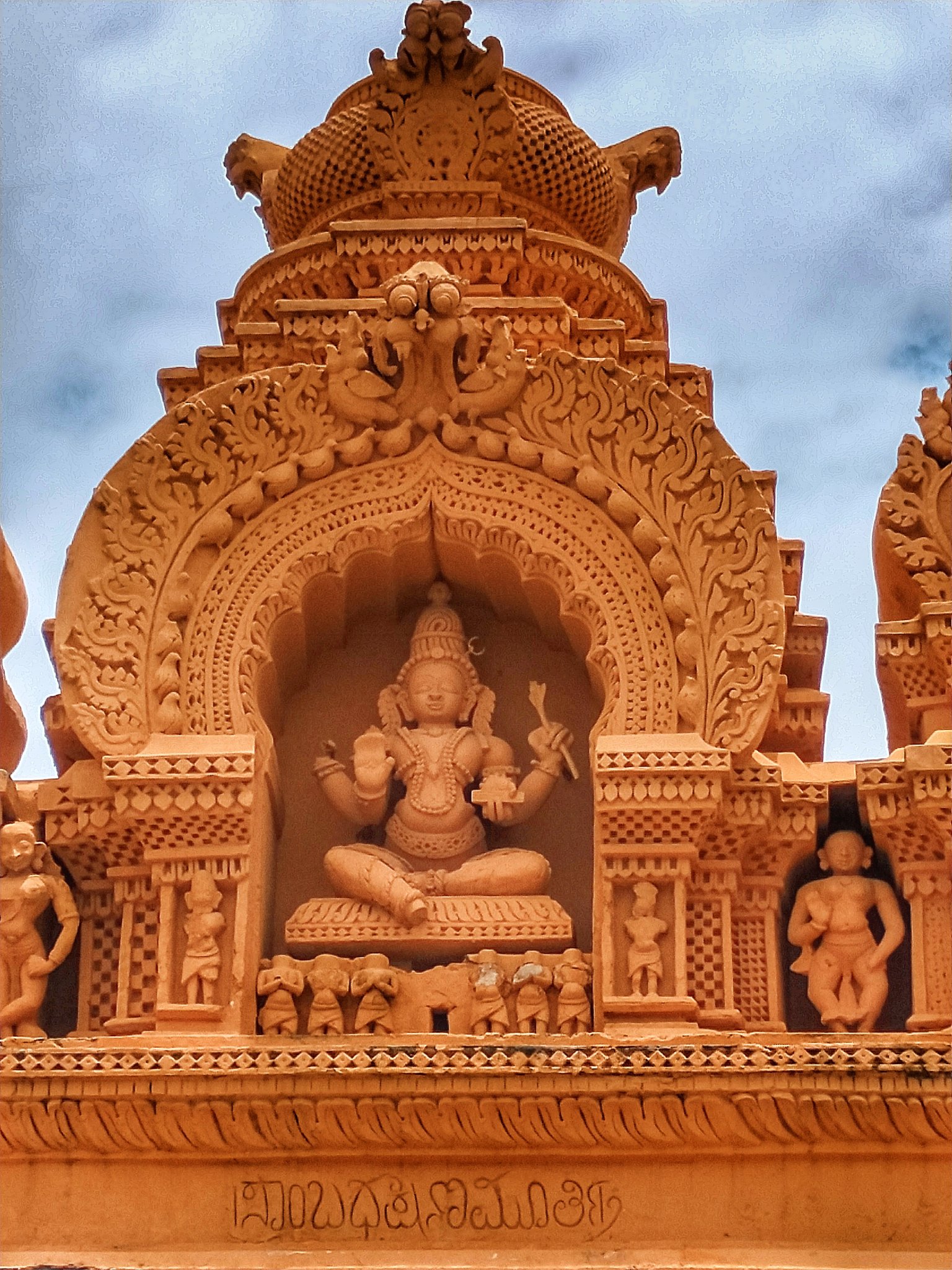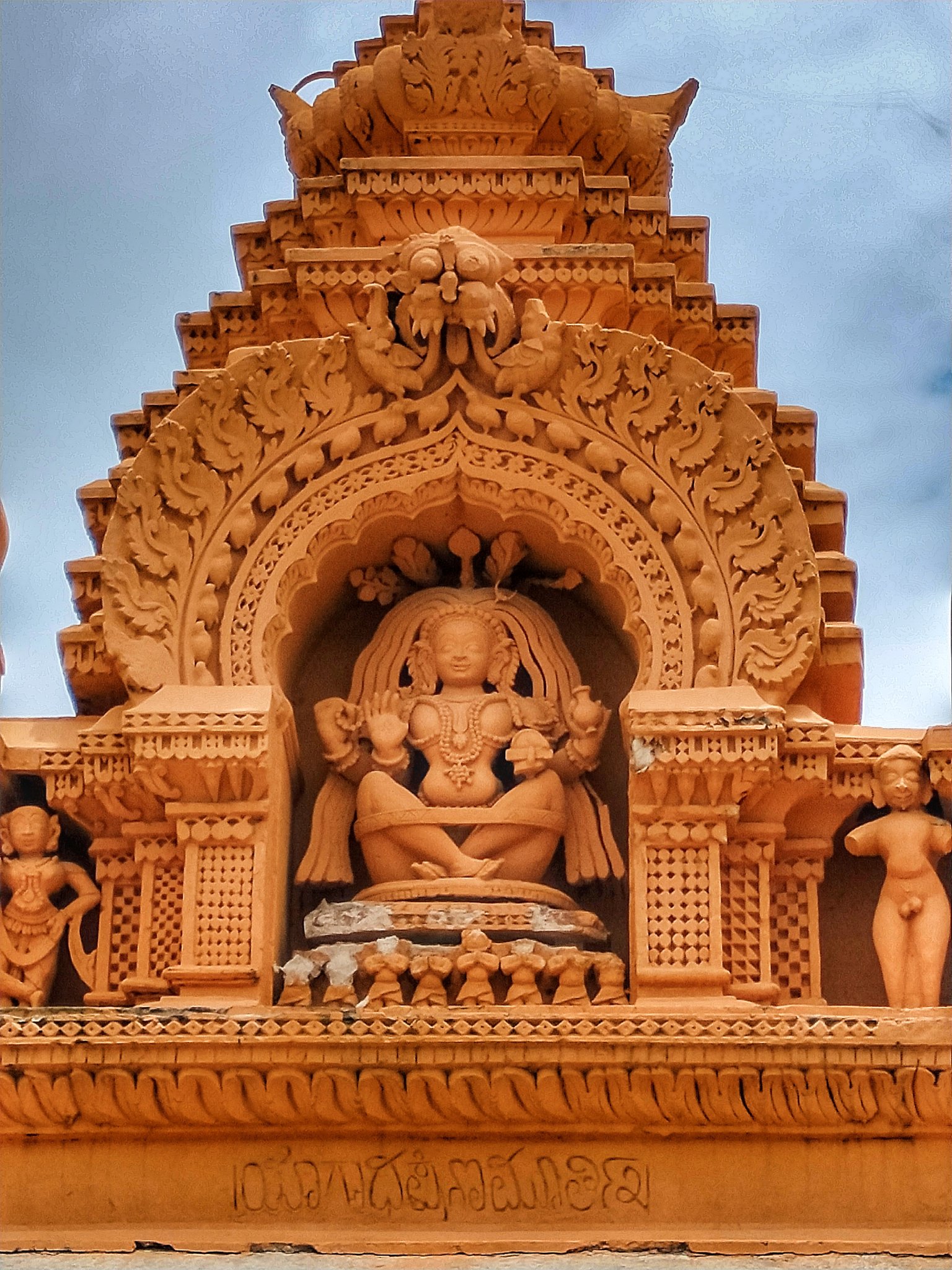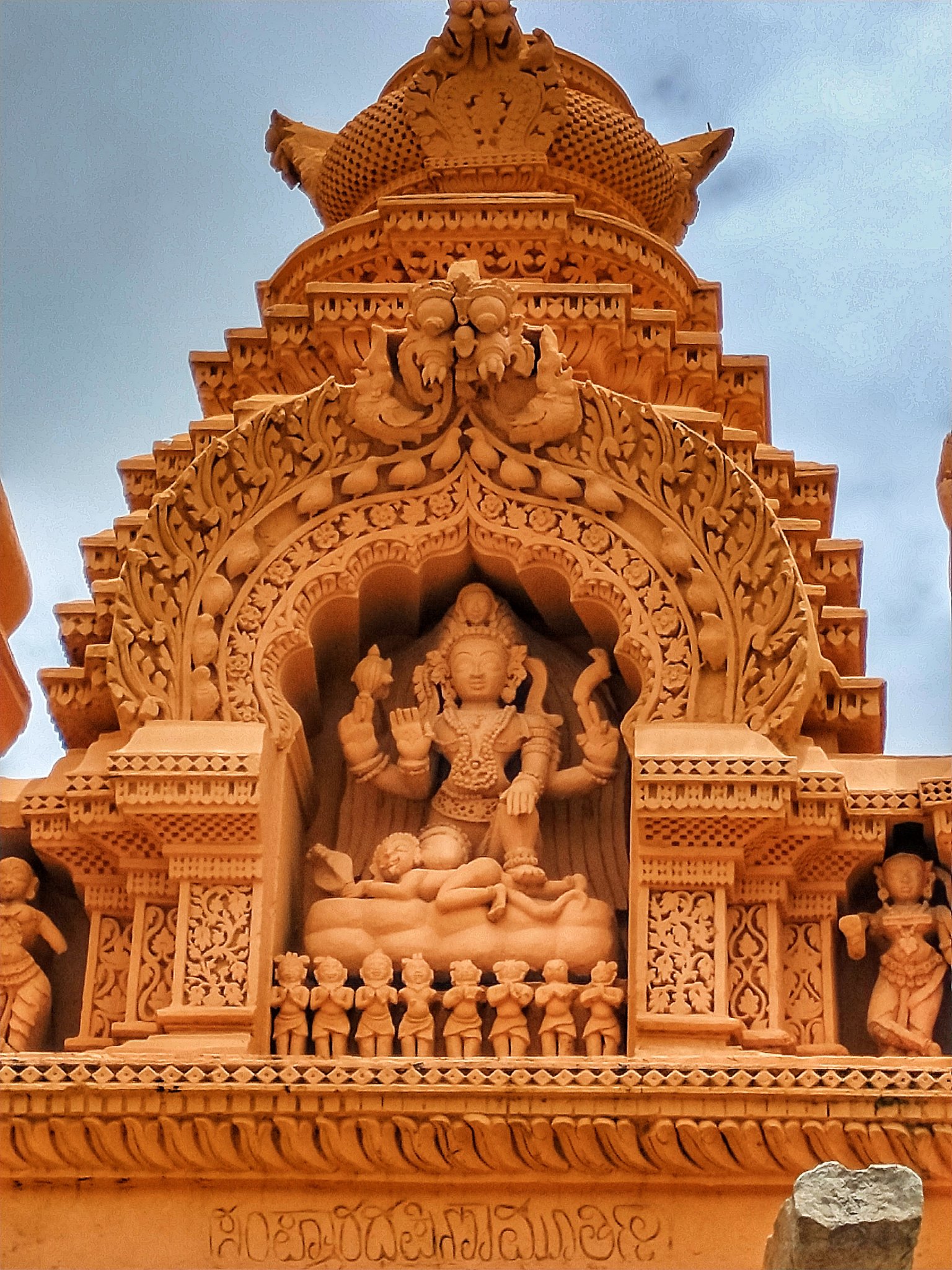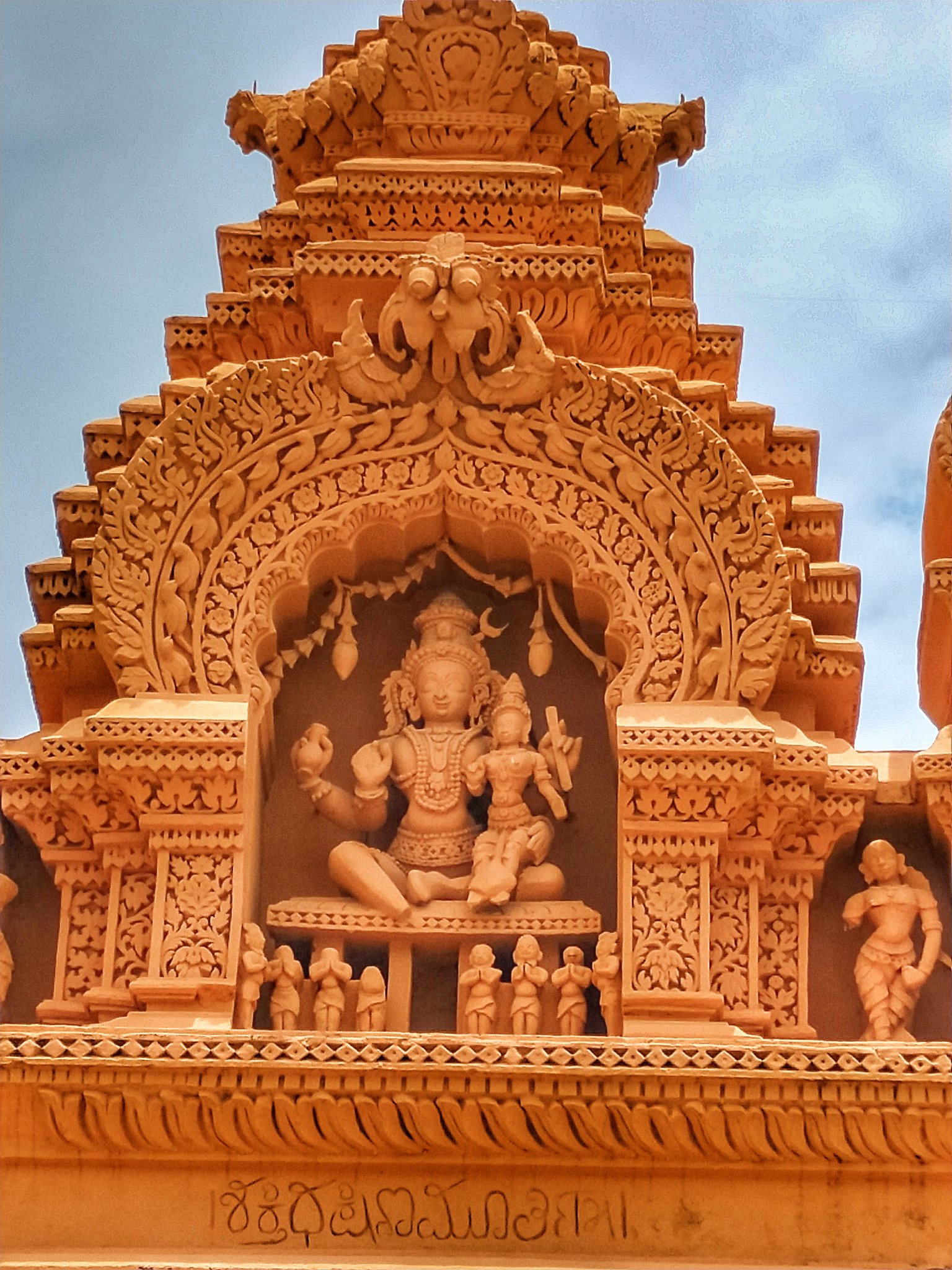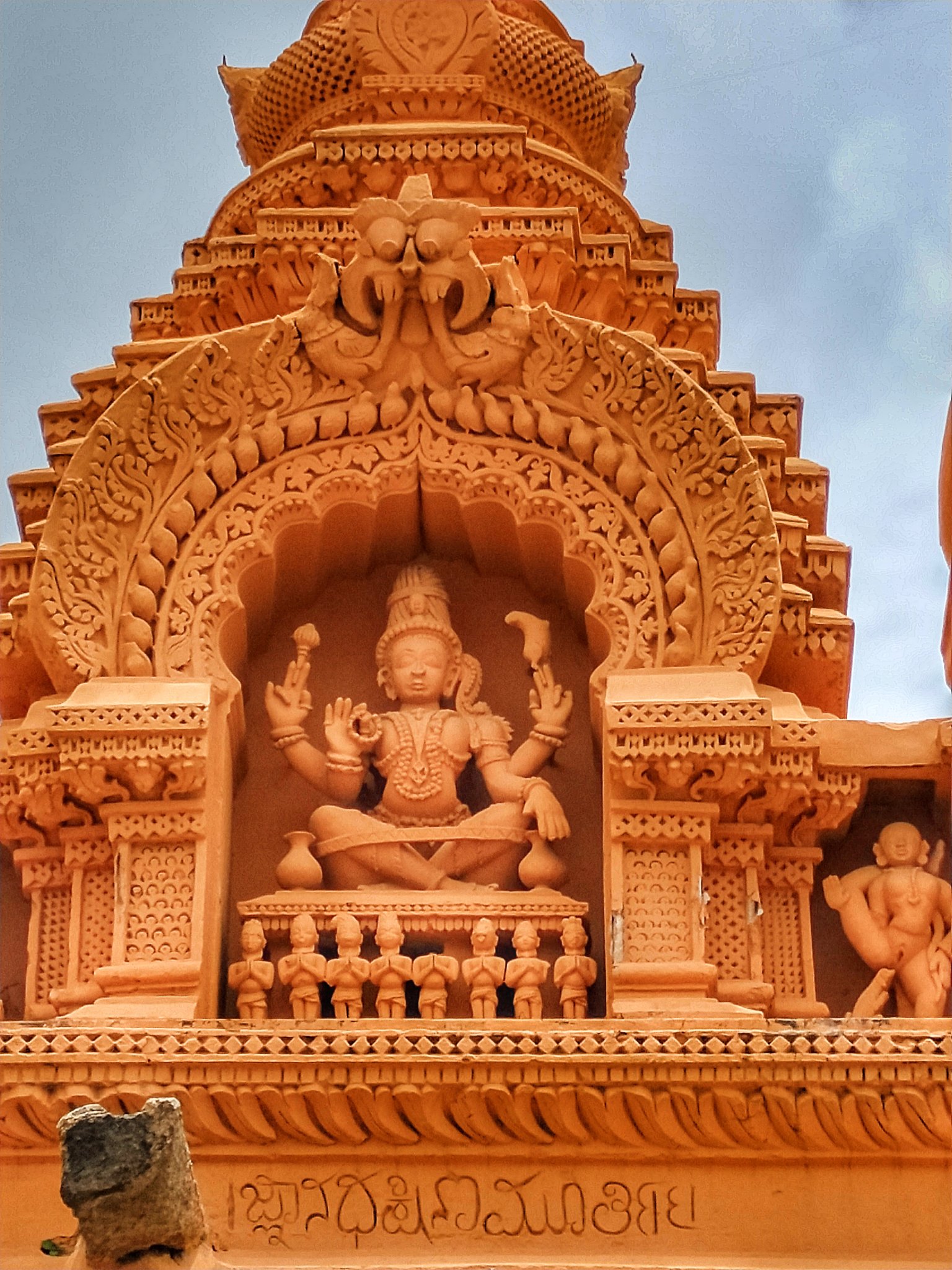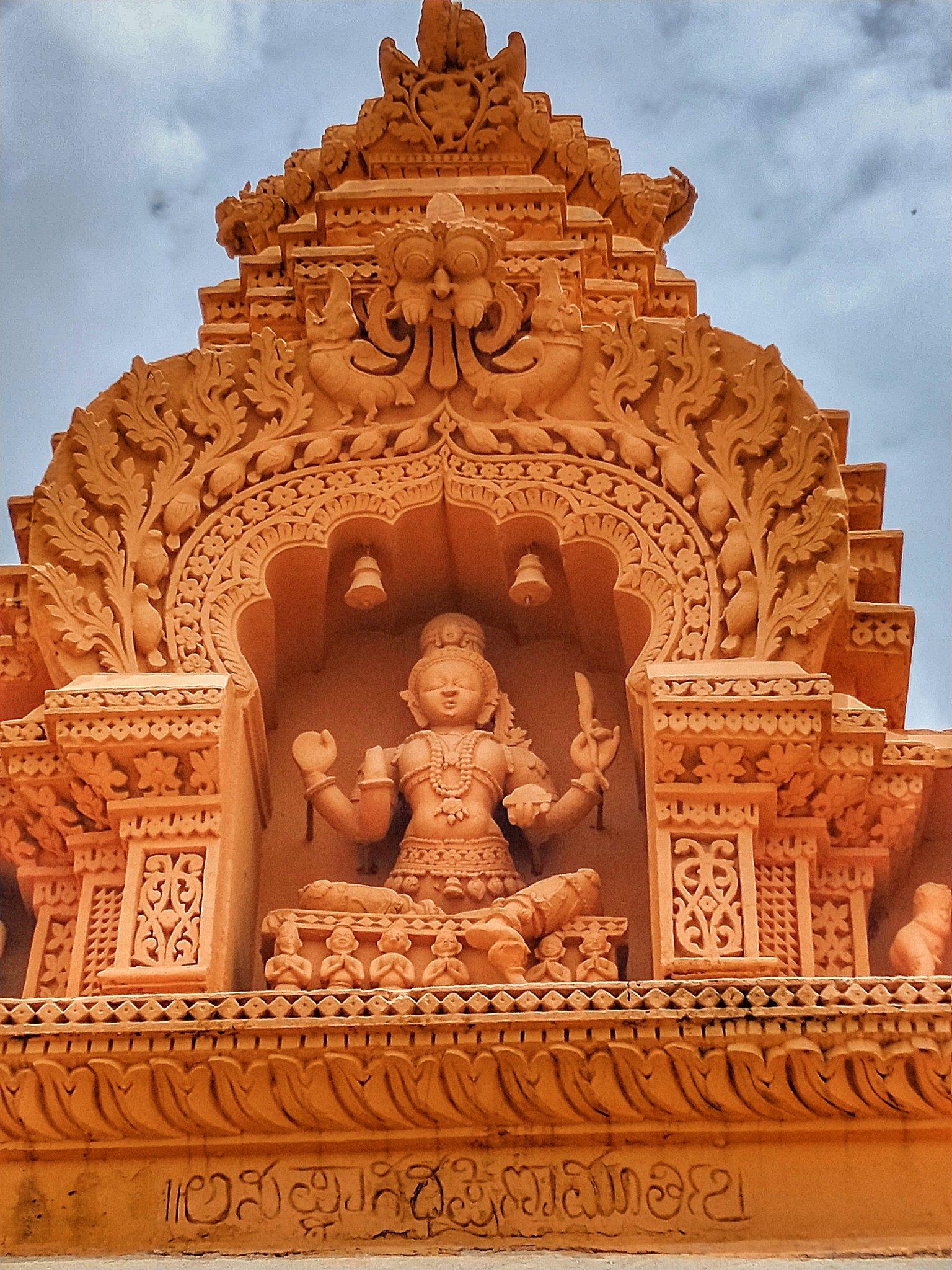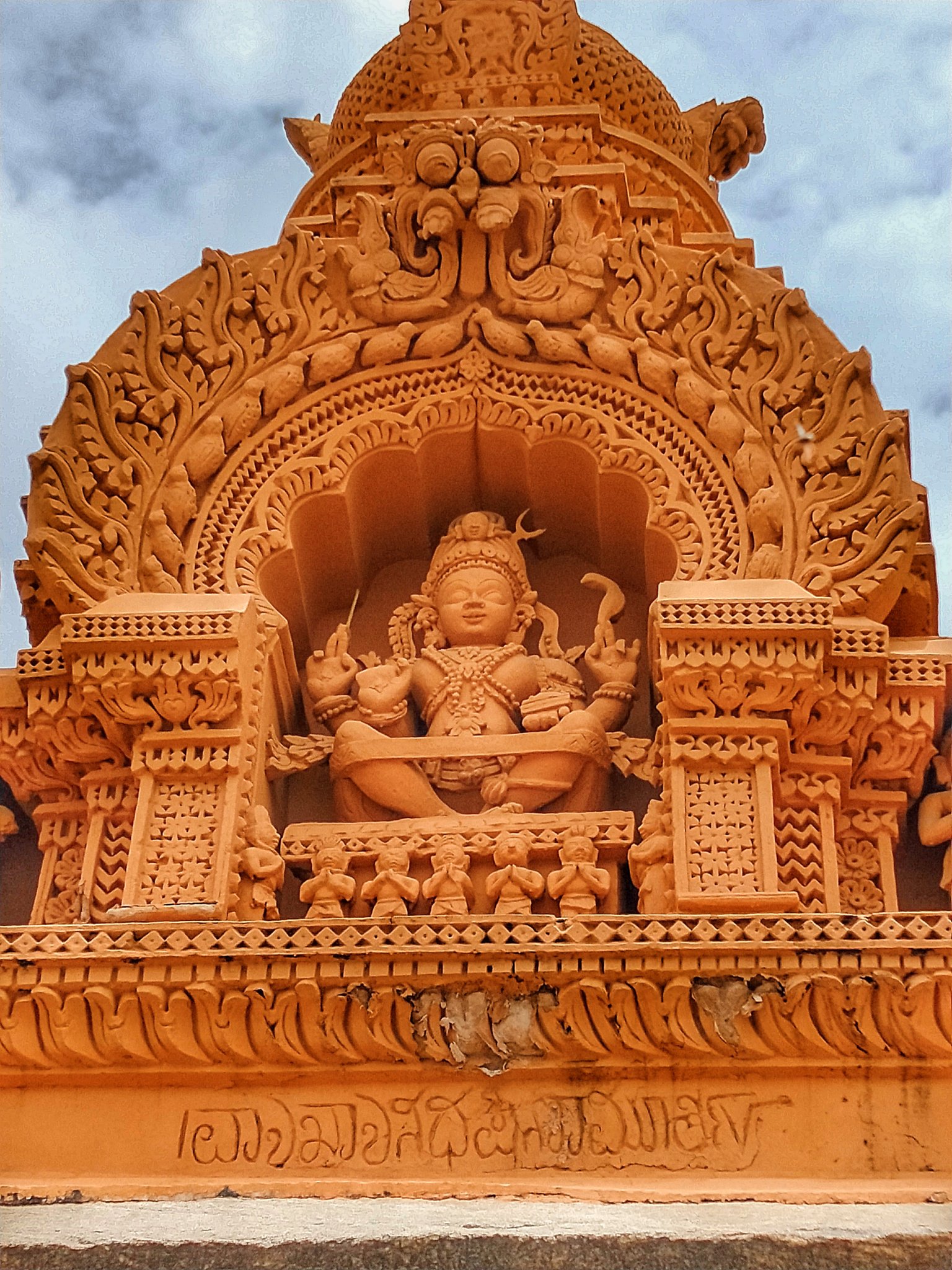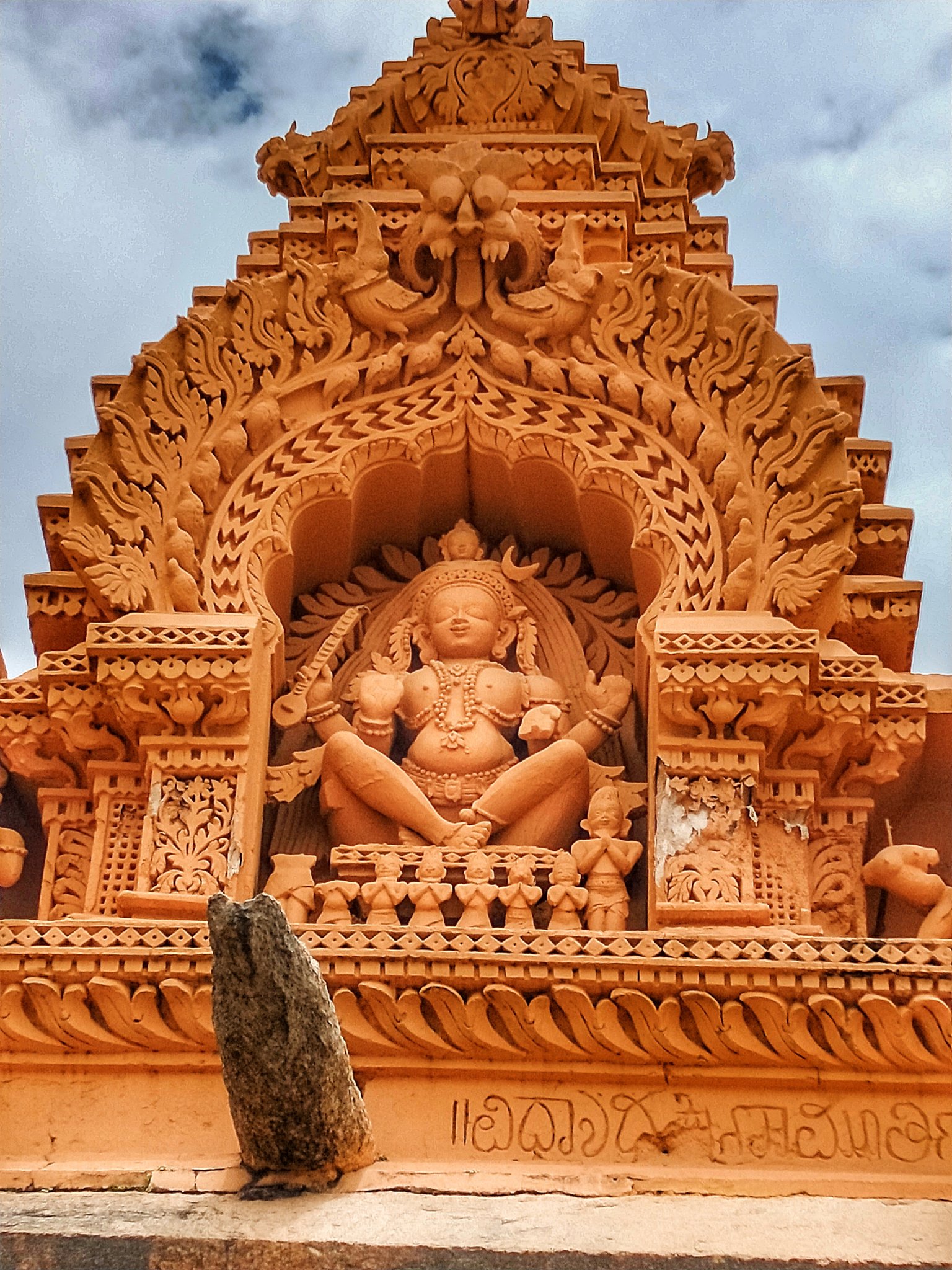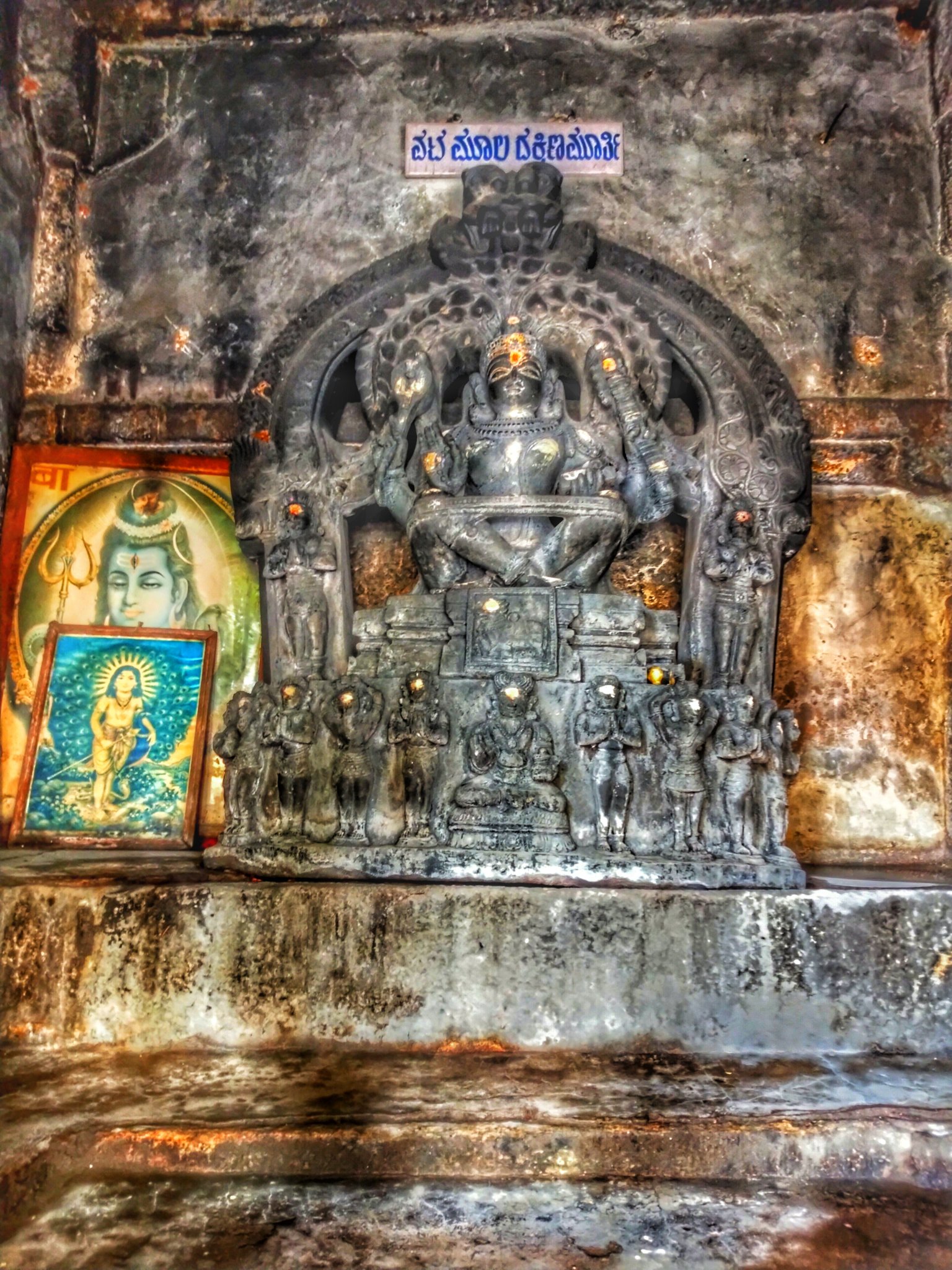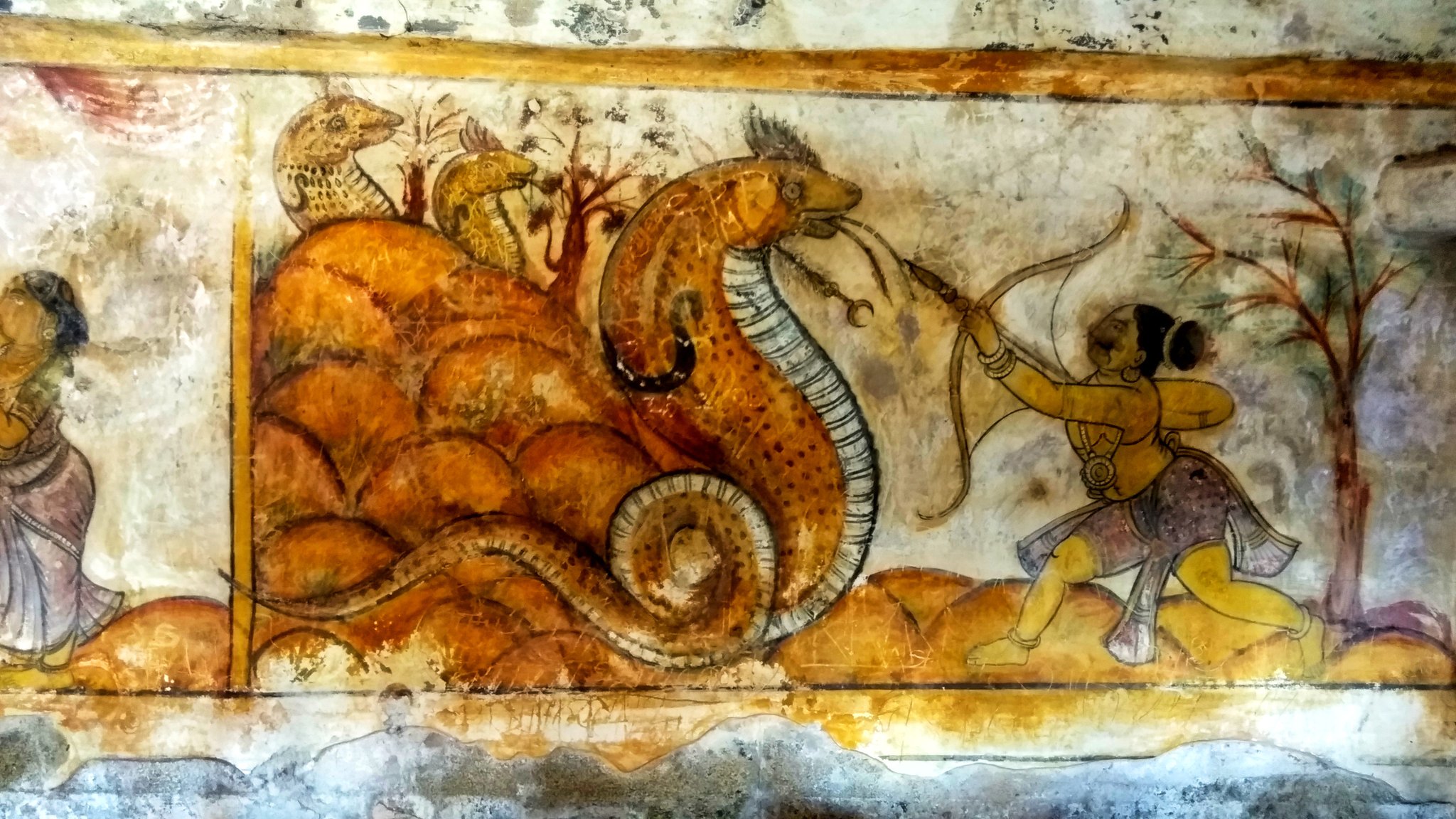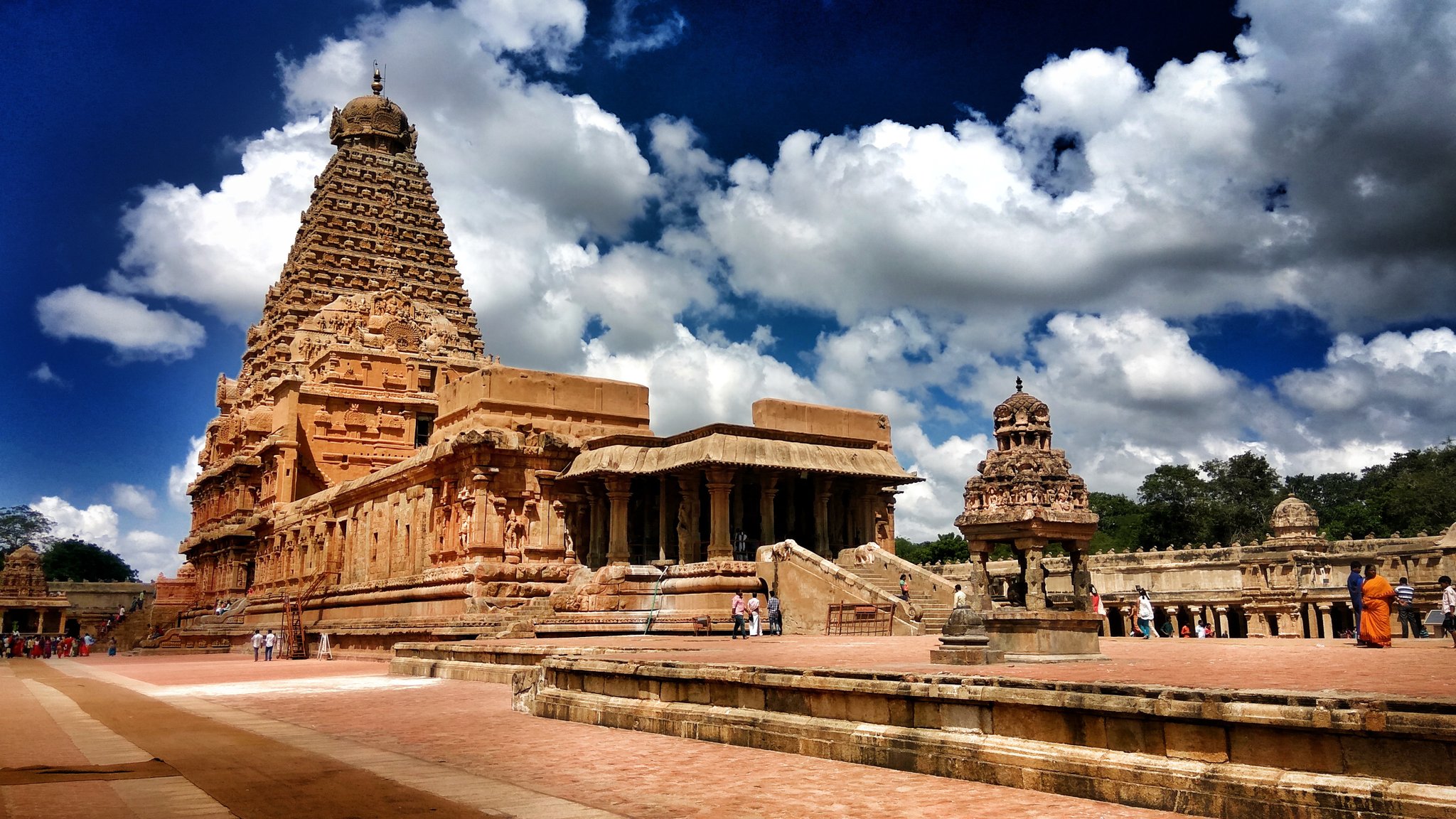 |
Brihadeeshwara Temple view from south-east
|
Built in the early 10th century by the great Raja Raja Chola, the Rajarajeshwaram as it was then called set new architectural standards for Temples to emulate. Its sheer size & grandeur remains unmatched after a 1000 years of its construction.
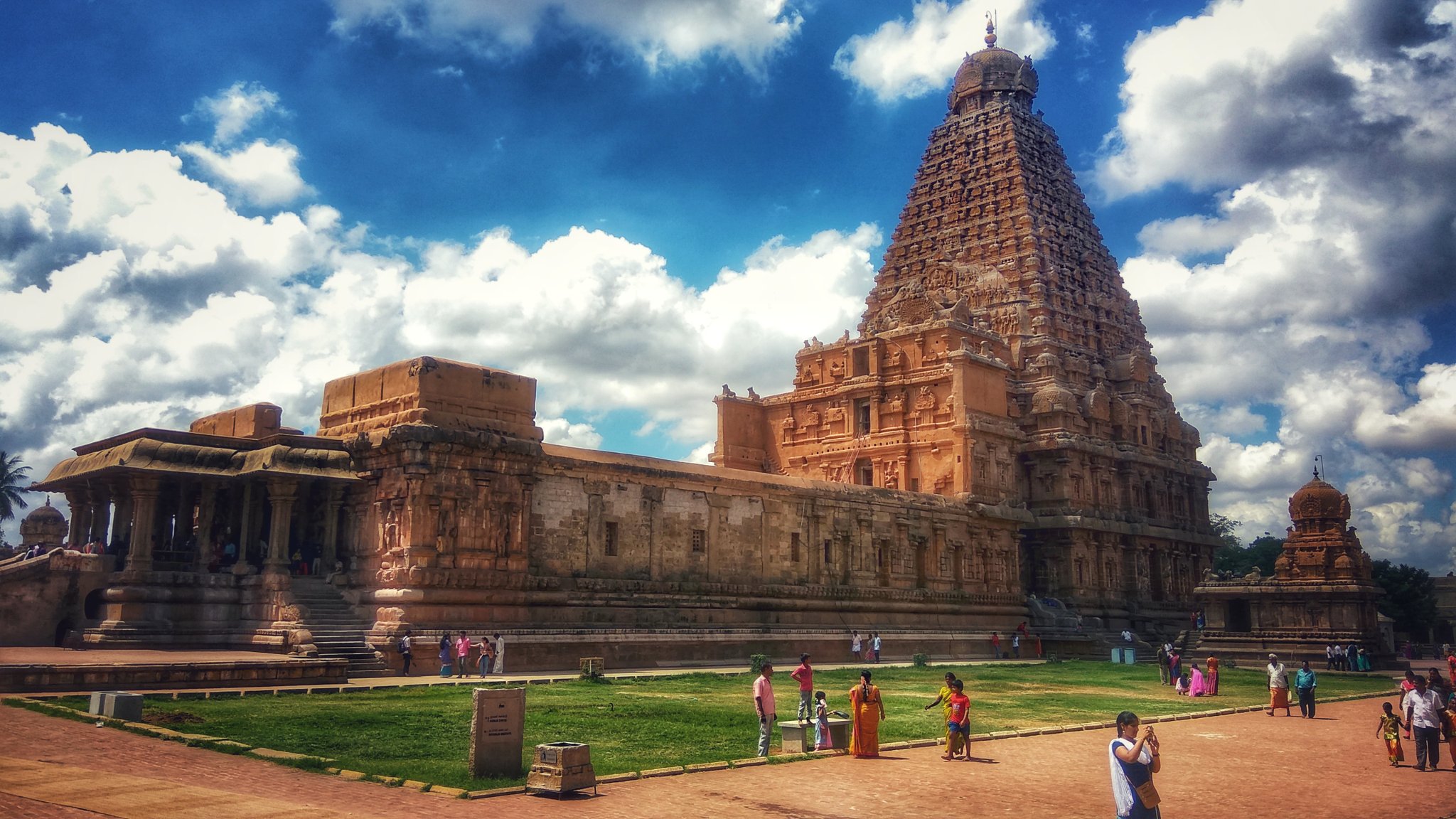 |
| Brihadeeshwara Temple view from north-east |
GOPURAMS
The Keralantakan Gopuram is one of the 2 Gopurams at the entrance of the Brihadeeshwara temple. It was built by Raja Raja Chola after be brought a part of the Chera ruled Kerala under his realm.
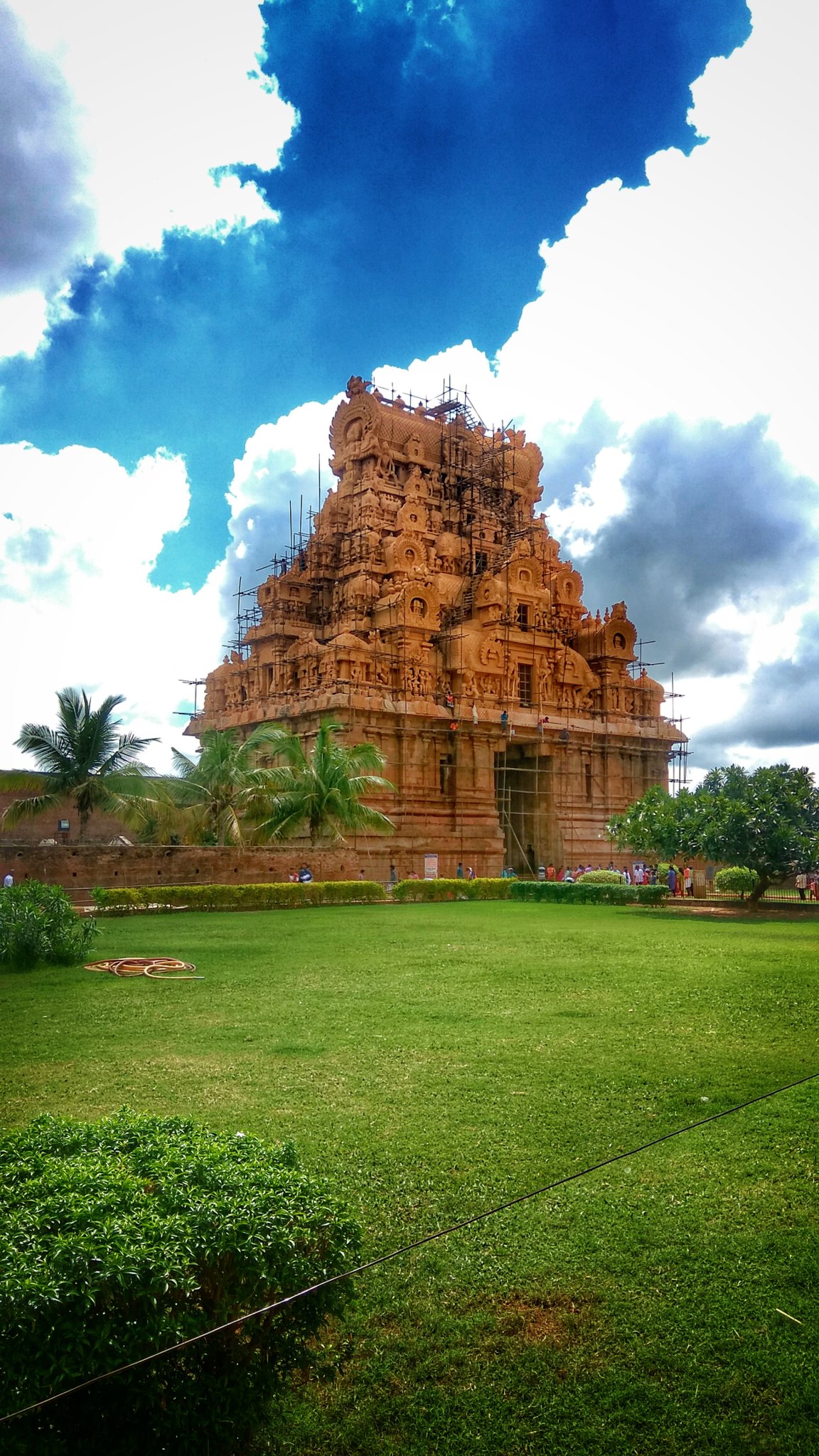 |
| Keralantakan Gopuram |
The 2nd Gopuram also known as Rajarajan Thiruvasal leads to the main Temple complex. While the Gopuram is gigantic in size, it pales in comparison to the main Vimana.
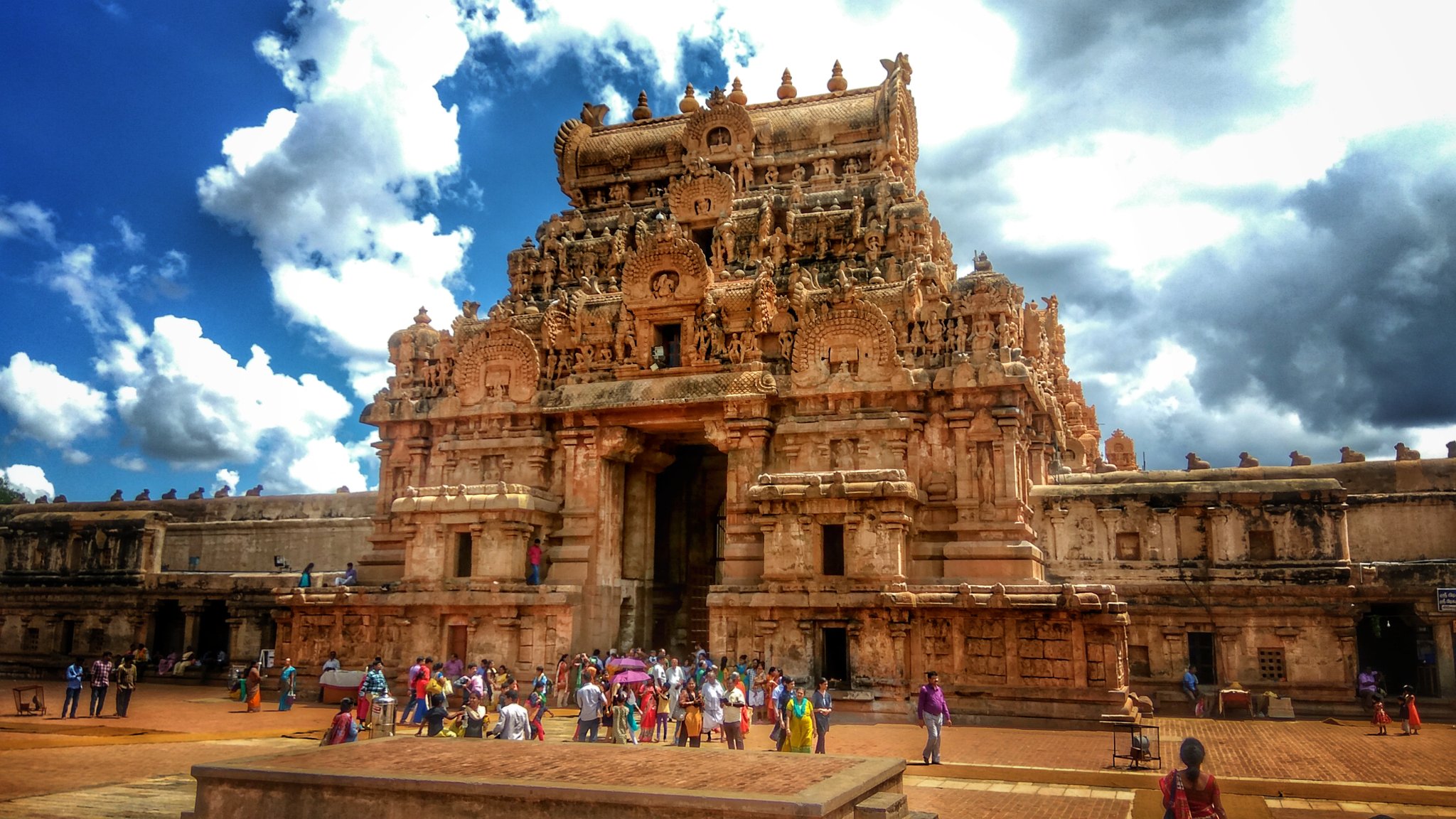 |
| Rajarajan Thiruvasal |
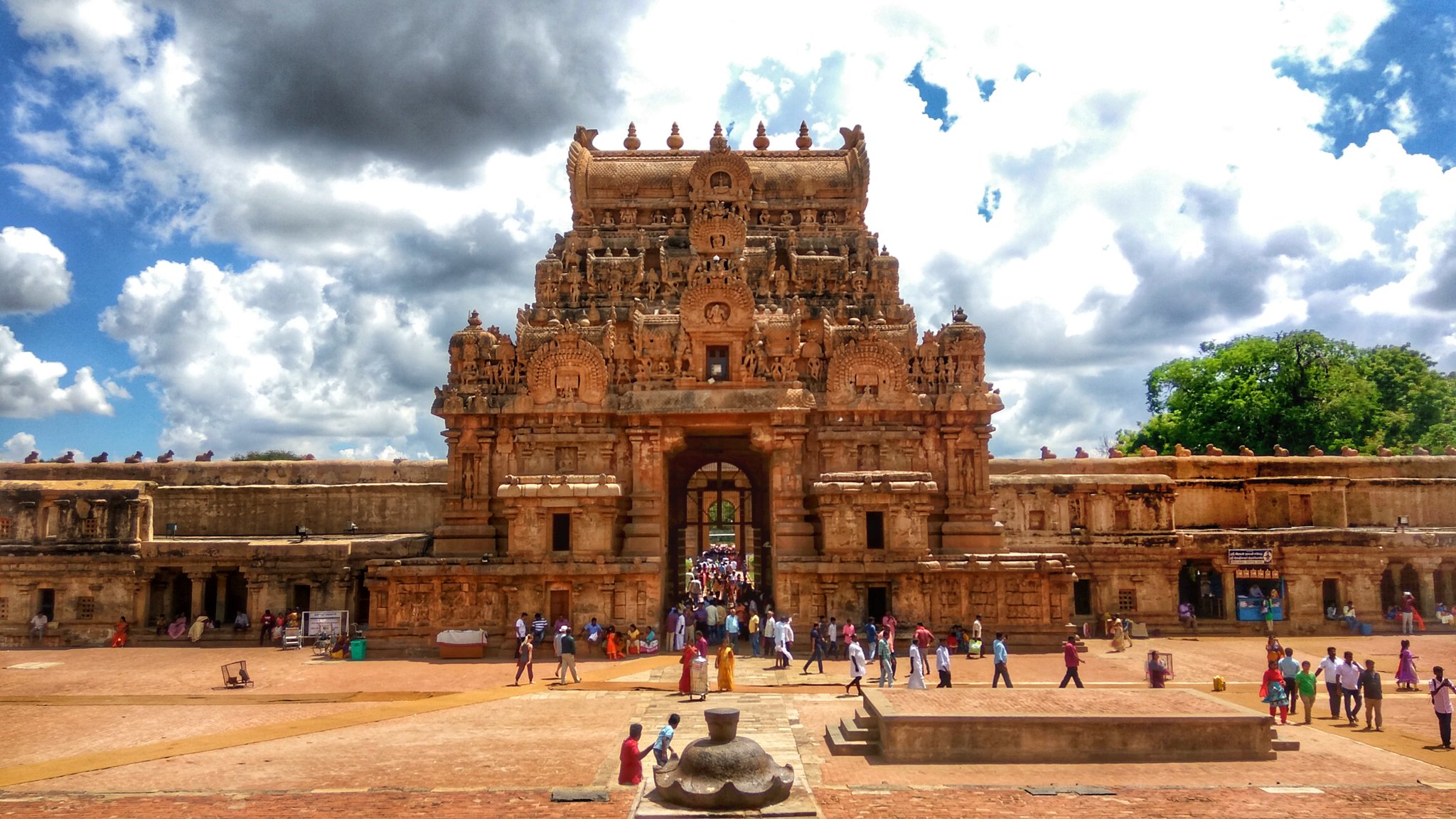 |
| Rajarajan Thiruvasal |
Nandi Mantapam
Apart from the Sri Vimana,the most eye catching structure in the Temple complex is the huge Nandi Mantapam,which houses the one of the largest monolitic Nandi in Bharat The Nandi Mantapam was constructed during the Vijayanagara-Nayak era in the early 16th century.
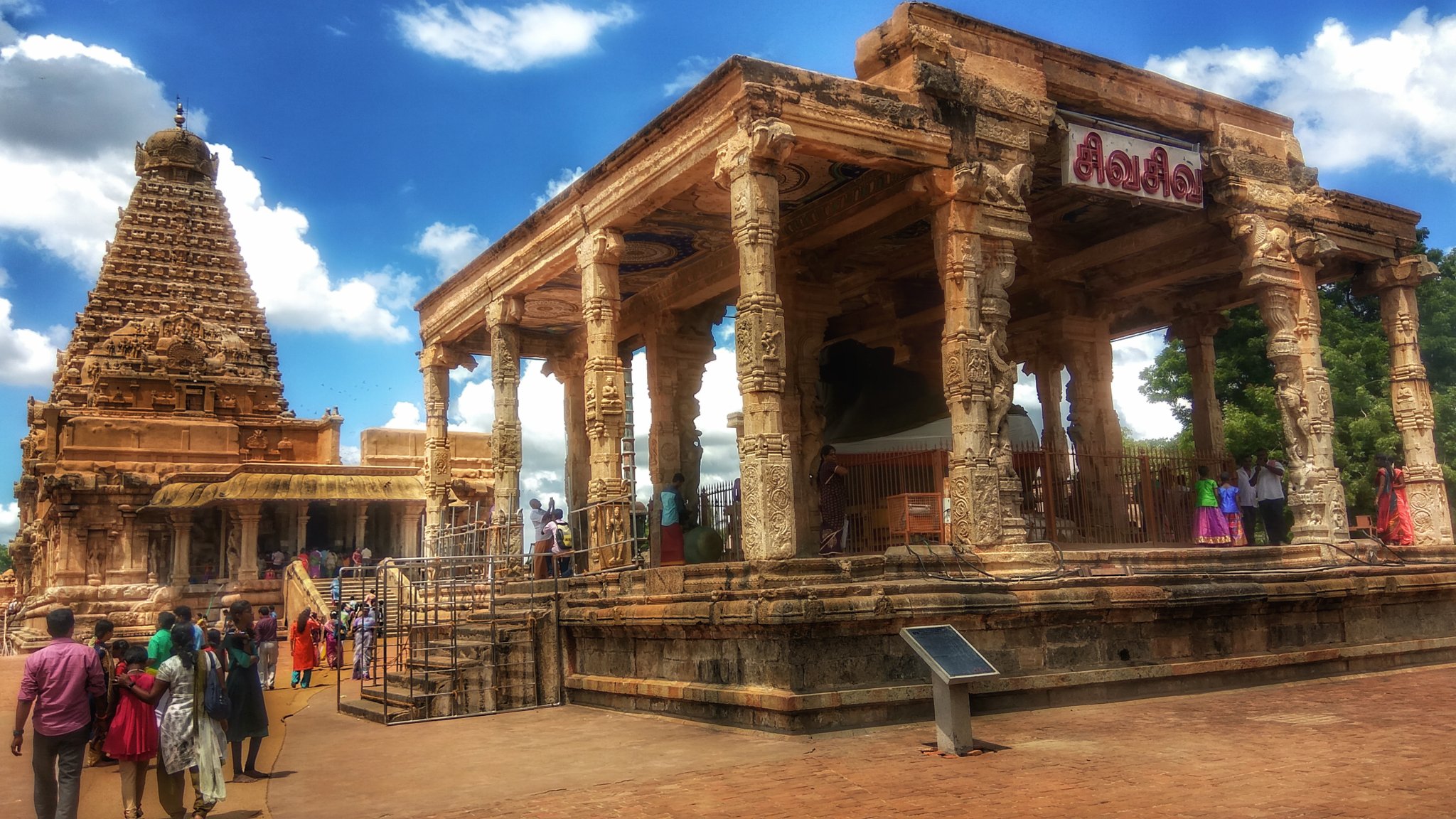 |
| Nandi Mantapam |
Weighing in at around a massive 25,000 kilos, it is the heaviest monolitic Nandi in Bharat. The celling of the Nandi Mantapam is adorned with fantastic Nayak/Maratha style ceiling murals. Sadly most of it is on the verge of fading away.
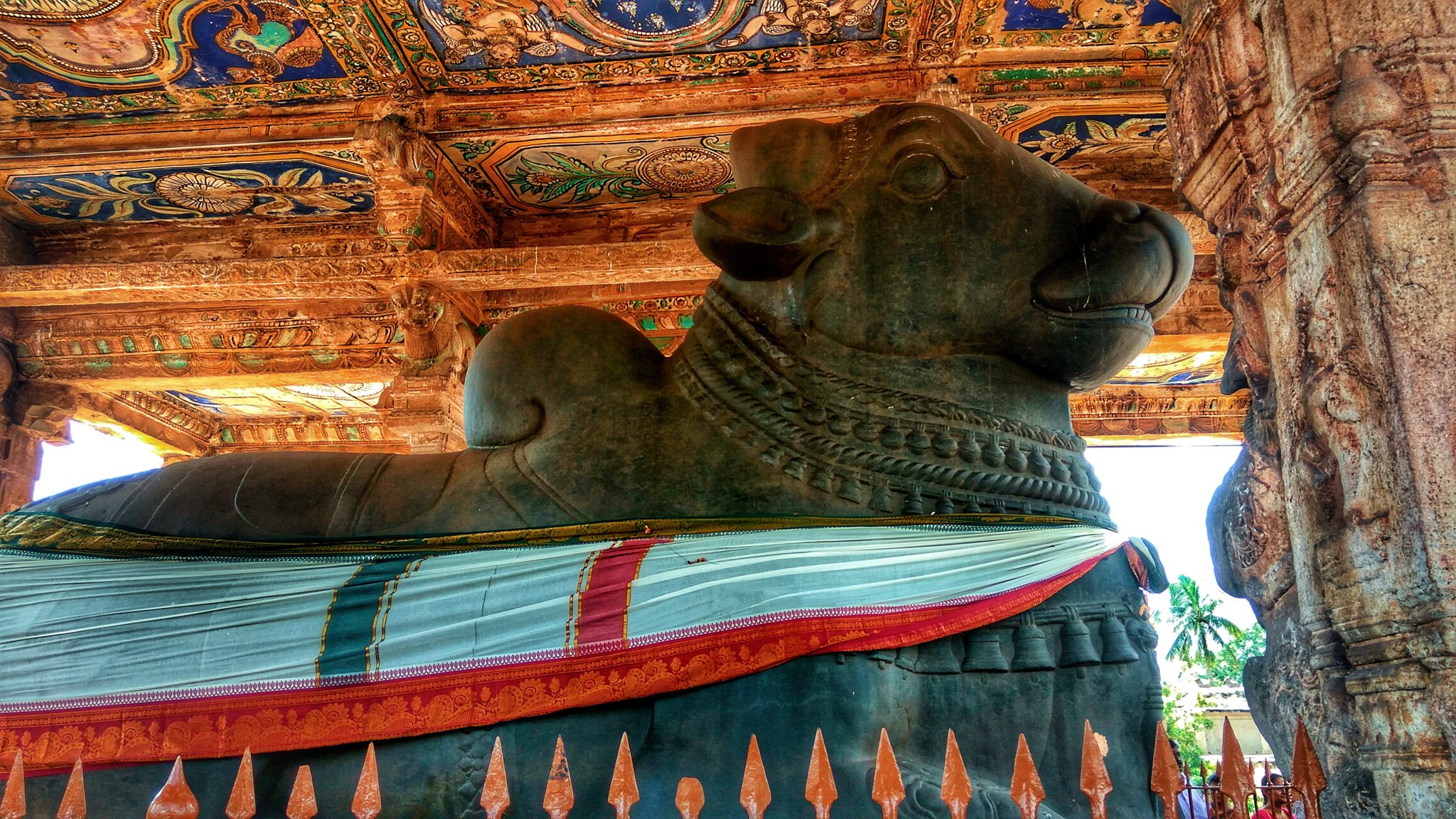 |
| Nandi |
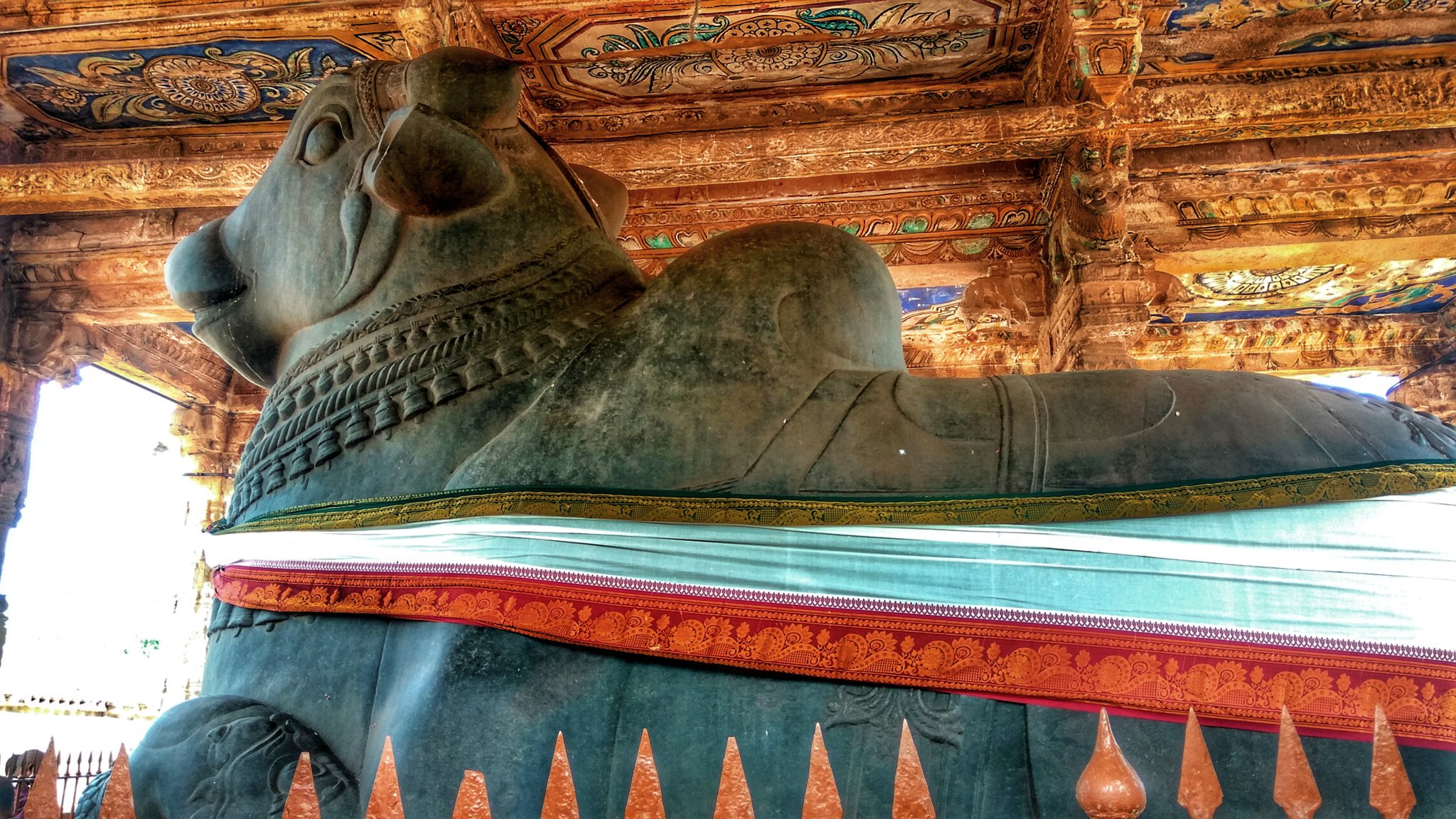 |
| Nandi |
View of the towering Sri Vimana & the Dwajasthambam from the Nandi Mantapam. They all line up perfectly collinearly with the Shiva lingam inside the Garbagriha, an exemplification of the mathematical prowess of the Cholas & subsequent Hindu Nayaka & Maratha rulers.
 |
| Sri Vimana from Nandi mantapam |
Sri Vimana
The sheer size of the 16 storeys Vimana leaves one overawed. Standing at 216 feet it was the tallest Vimana of its time.
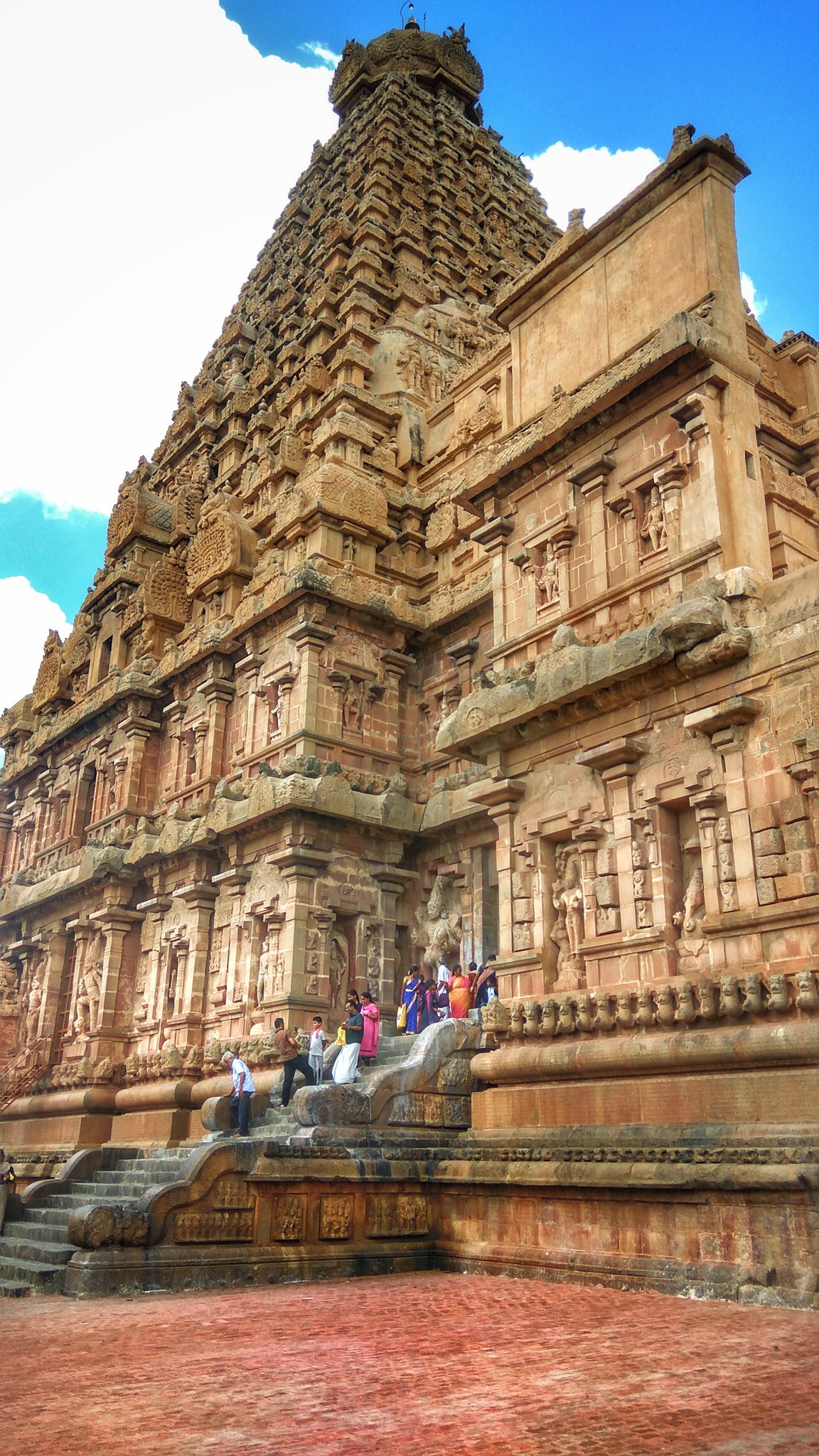 |
| Sri Vimana |
The southern face of the Sri Vimana. The massive Dwarapalakas are also seen. They are 3 times the size of an average human.
 |
| Southern face |
The western face of the Sri Vimana, when it becomes apparent, just the sheer size makes one feel over powered & insignificant. The octagonal granite Shikhara at the very summit of the Vimana weighs in at around 80,000 kilos. Over 3 times the weight of the Nandi below.
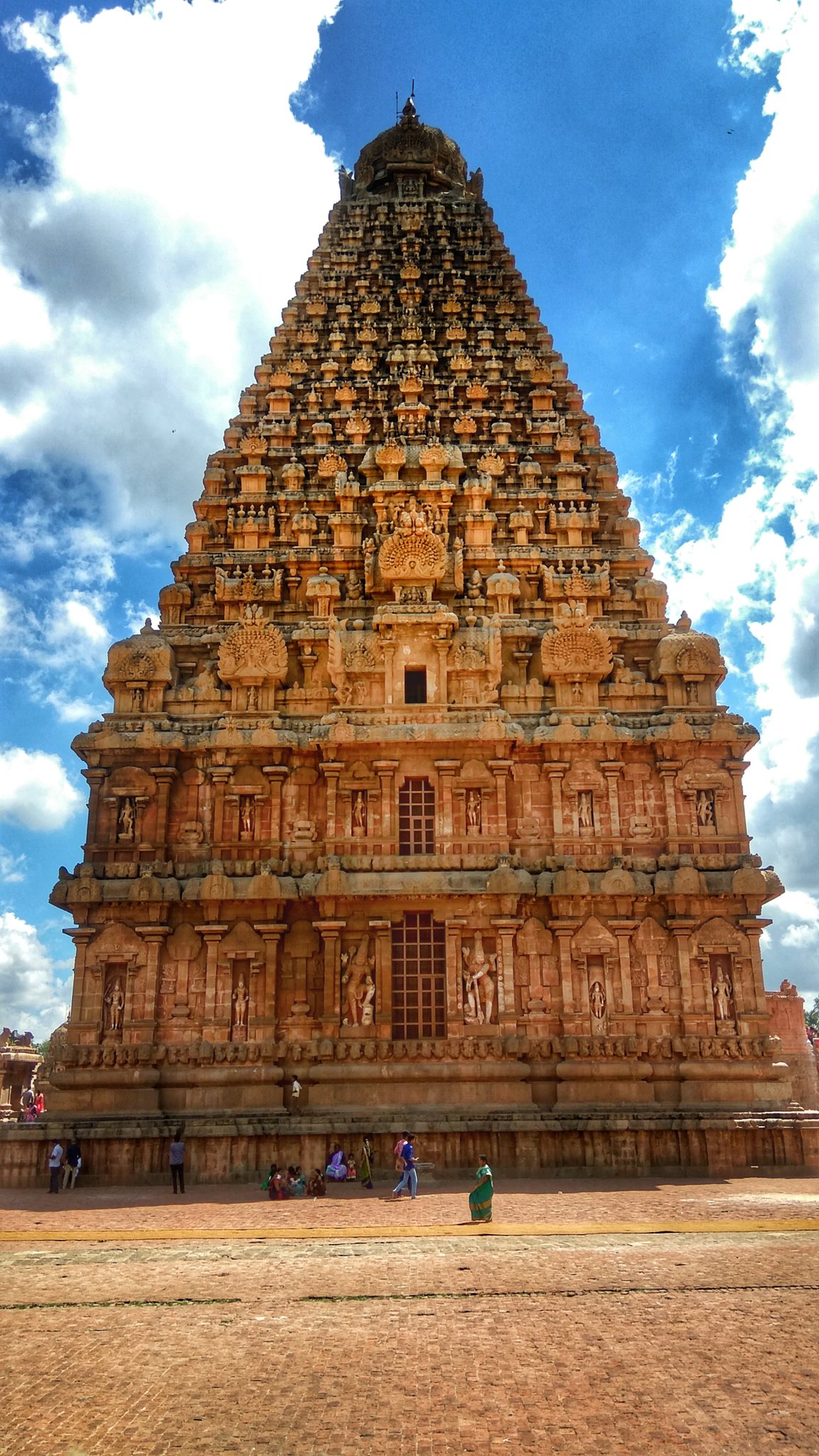 |
| Western face of Sri Vimana |
The Shikhara (brightened here) is made four blocks of granite. A nearly 6 km inclined wooden ramp was built to hoist the 4 blocks to the top & assembled. It weighs at around 80,000 kilos. It is worth mentioning here that Thanjavur lies in the vast plains of Kaveri basin, just 60m above sea level There are no mountainous ranges anywhere in a 75 kms radius. Its just plains.
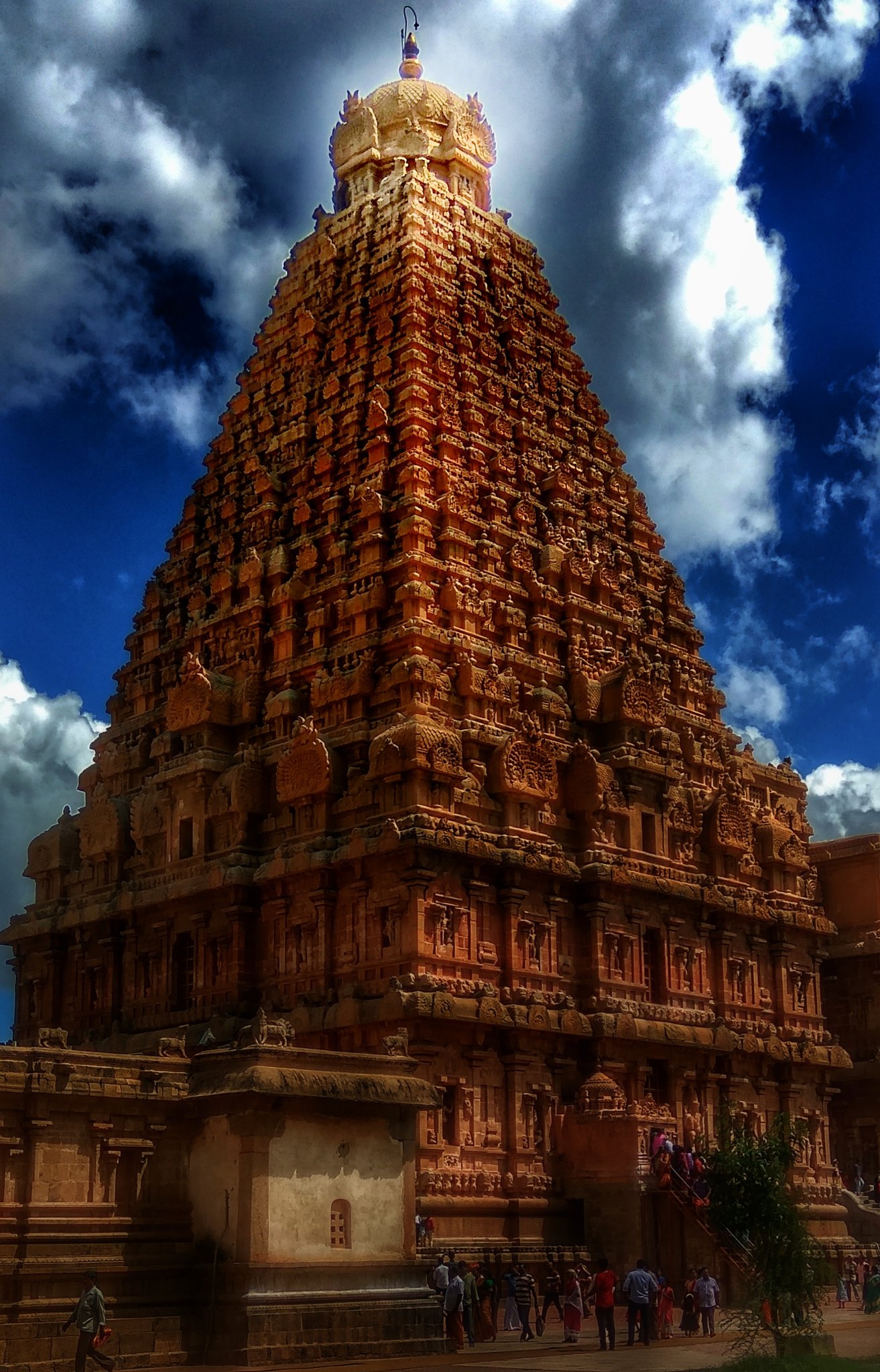 |
| Shikhara |
The Cholas had to source the Granite required for construction from 100's of miles away. The engineering feat behind transportation of the material & finally scaling it all the way up onto the 200+ feet Vimana deserves a post of its own. Seen here is the Vimana's northern face.
 |
| Northern face of Sri Vimana |
Mural Paintings
Now we will take a look at the famous mural paintings at the temple, starting with Goddess Gaja Lakshmi flanked on either side by elephants.
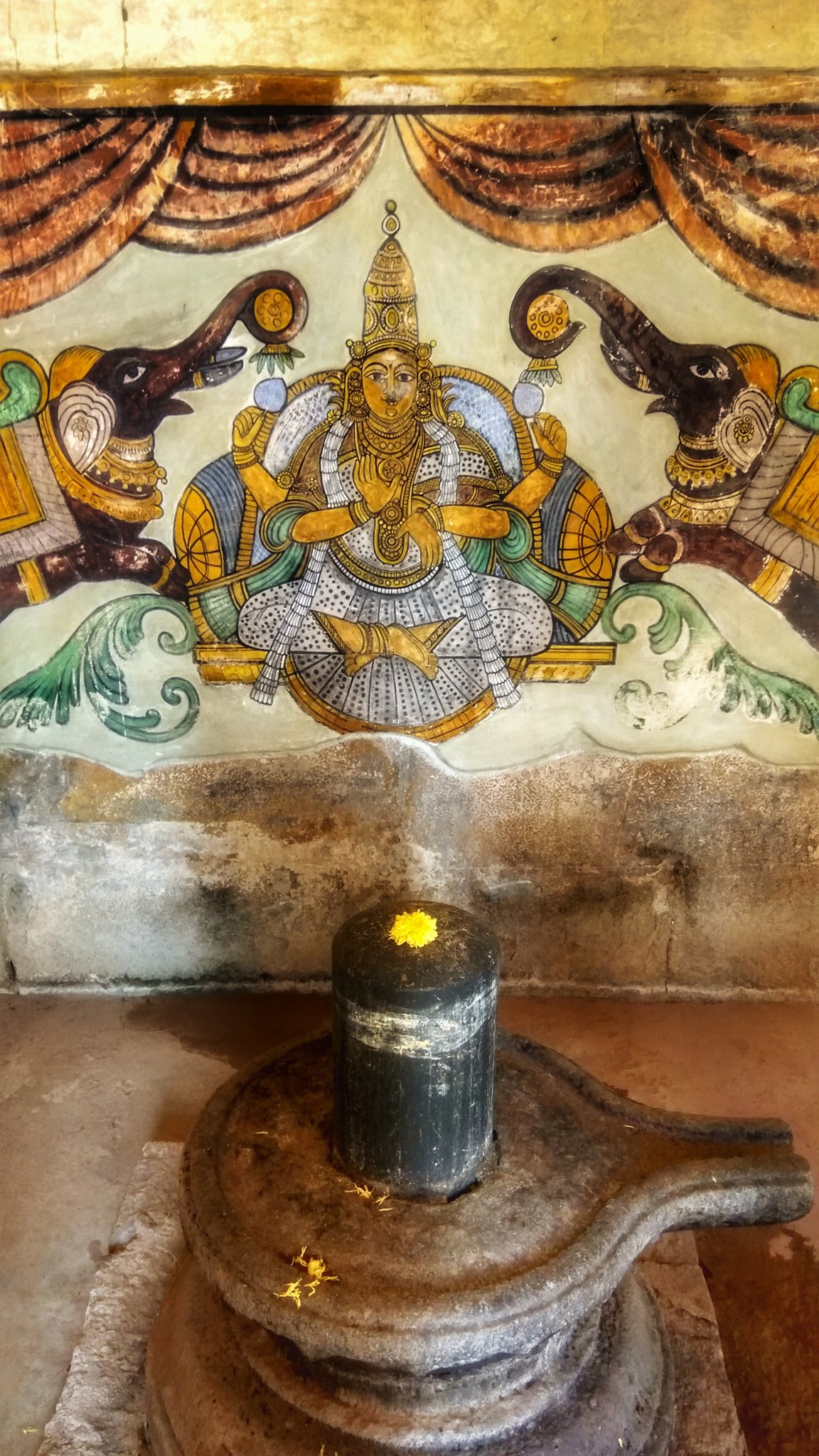 |
| Gaja Lakshmi |
A mural painting of Uma-Maheshwara, seen on either side are Lord Shiva's attendants, the Ganas.
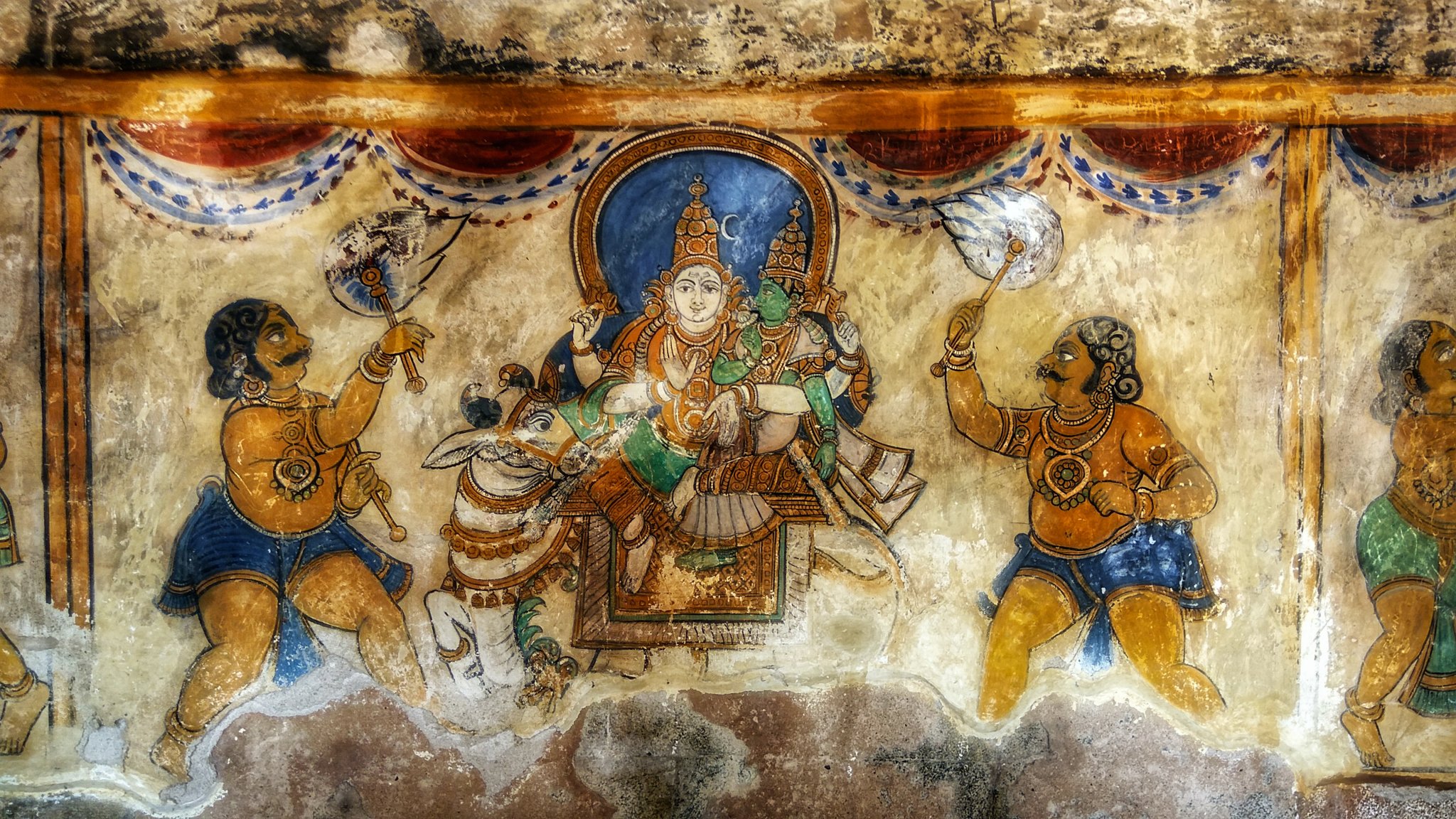 |
| Uma Maheswara |
A painting of Lord Ganesha, on either side are Riddi & Siddi. Also seen is his Vahana, Mooshika.
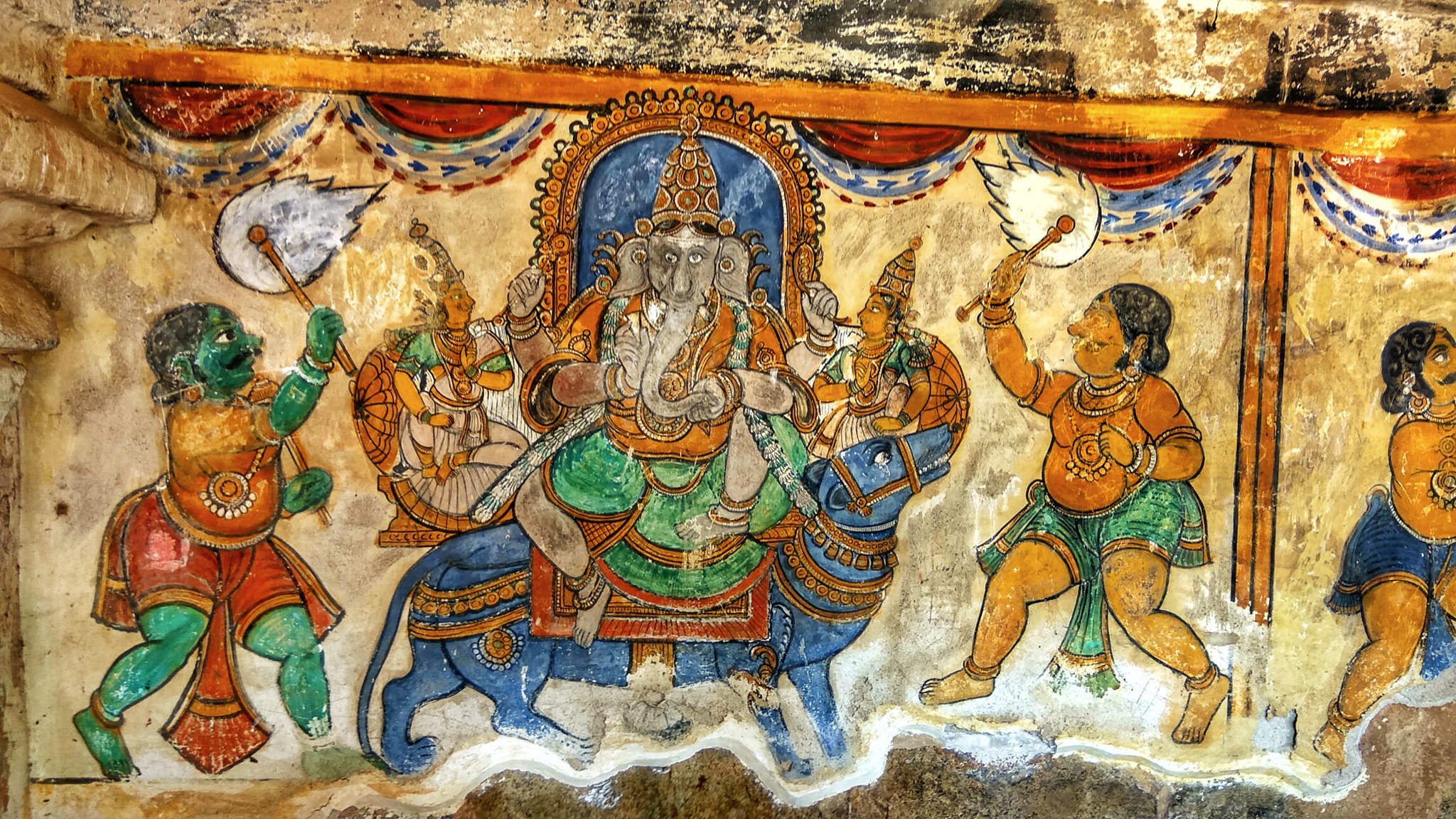 |
| Ganesha |
A painting of Lord Subramanya with his consorts, Valli & Devayani. Also painted is his Vahana, the peacock.
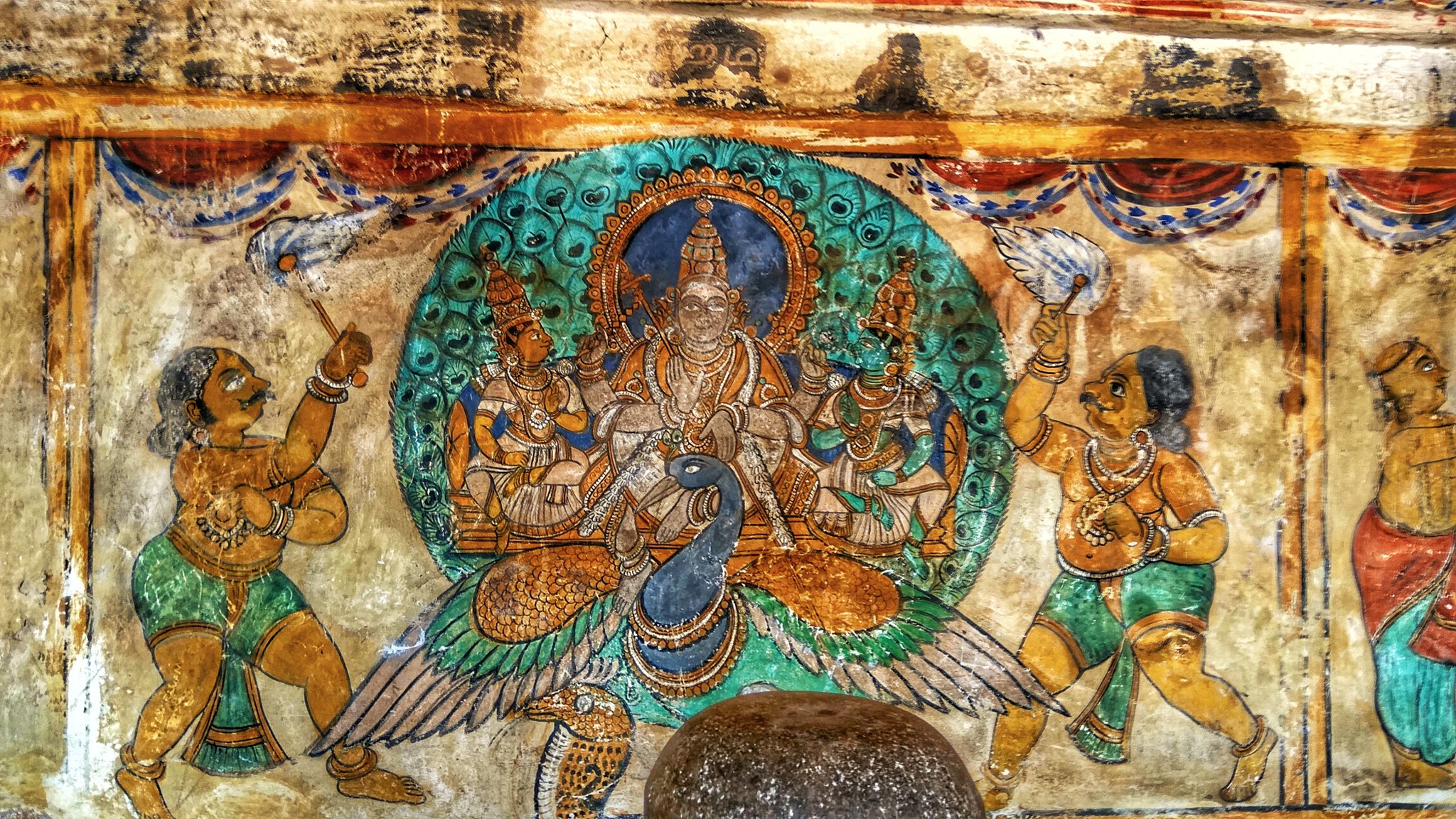 |
| Subramanya |
Lord Maha Vishnu performing Kanyadhana of his sister Goddess Parvathi to Lord Shiva. Also known as Meenakshi Sundereshwarar Kalyanam.
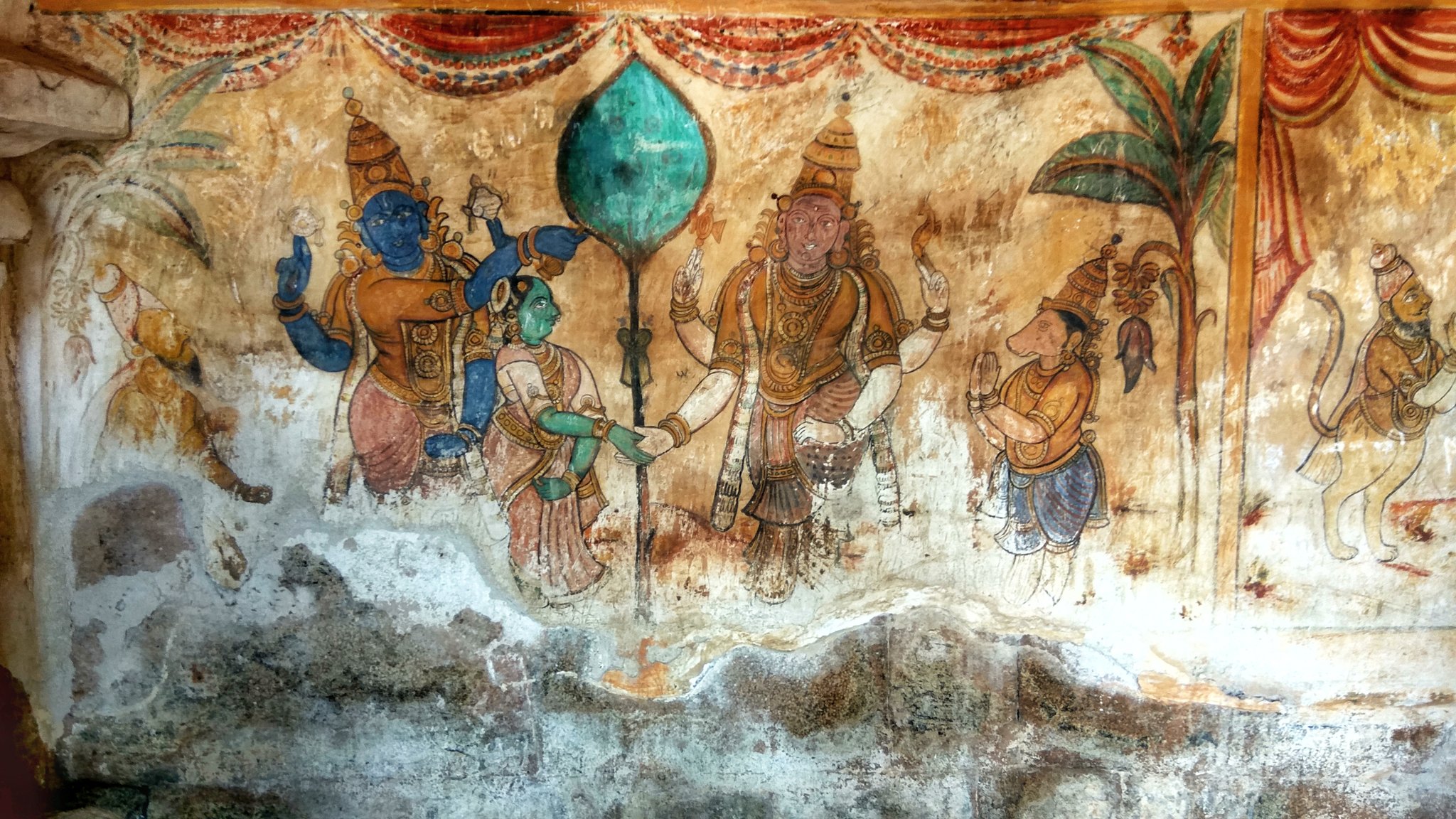 |
| Shiva-Parvathi wedding |
Goddess Durga as Mahisasuramardhini
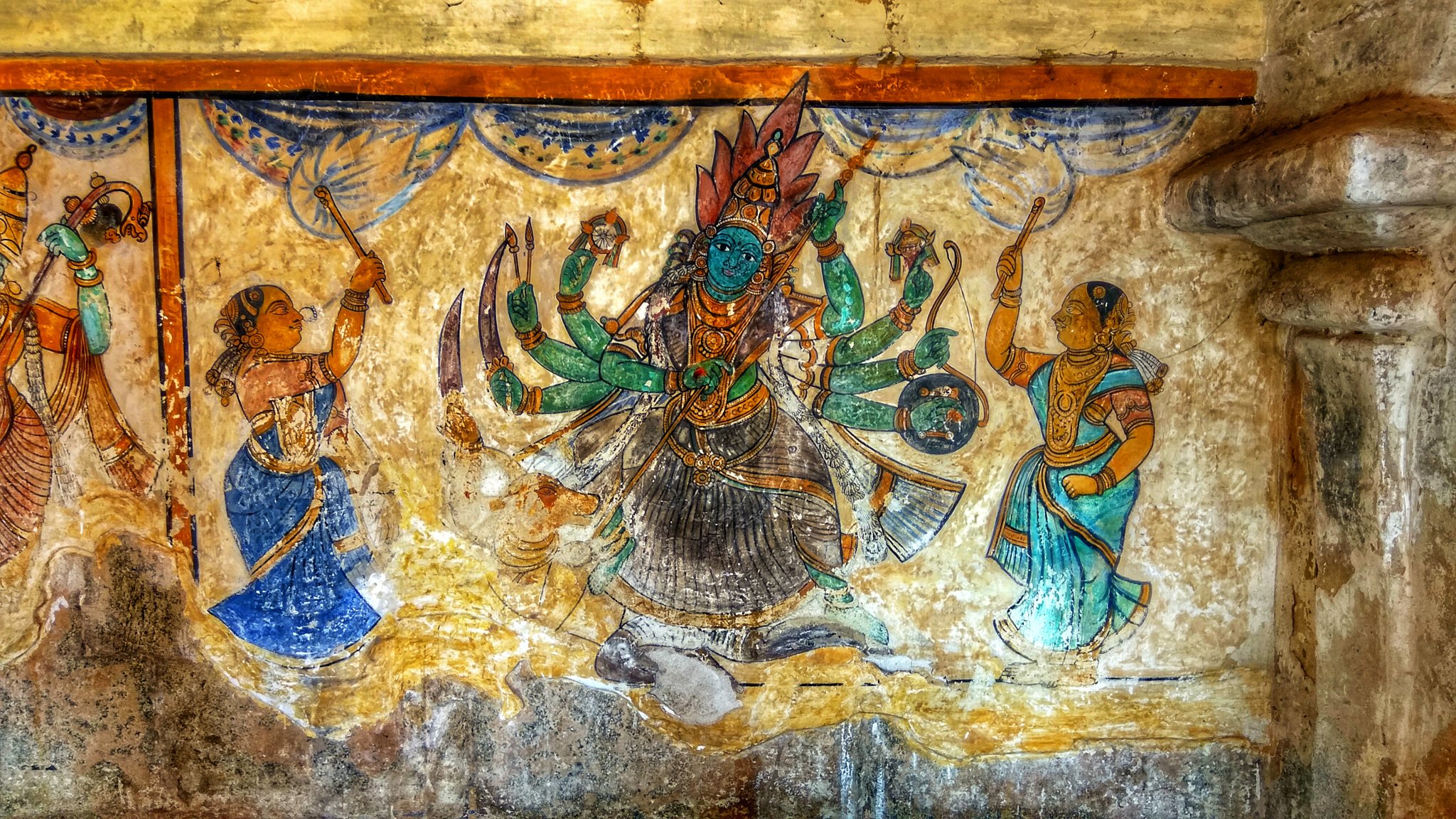 |
| Durga |
A marvelous mural painting of Goddess Saraswati playing the Veena. On her left his Sage Narada playing his instrument known as Mahati. On the right is Tumburu, the Gandharva & the best among all singers
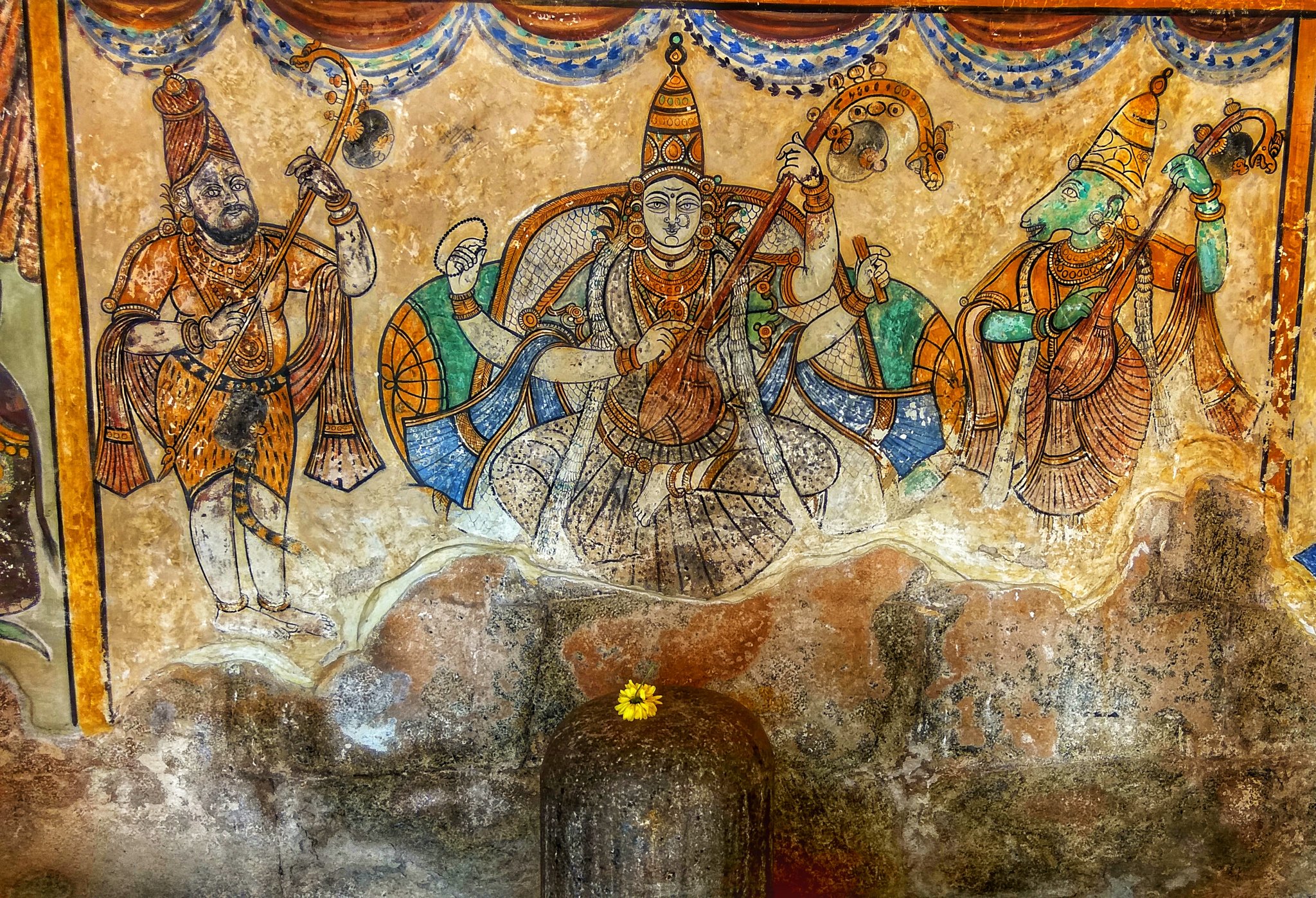 |
| Saraswathi |
A fantastic depiction of Elephant Pushpadanta performing abhishekam to the Shiva Lingam below the Jambu Vriksha. This story is the whole basis of the Jambukeshwara temple at Srirangam.
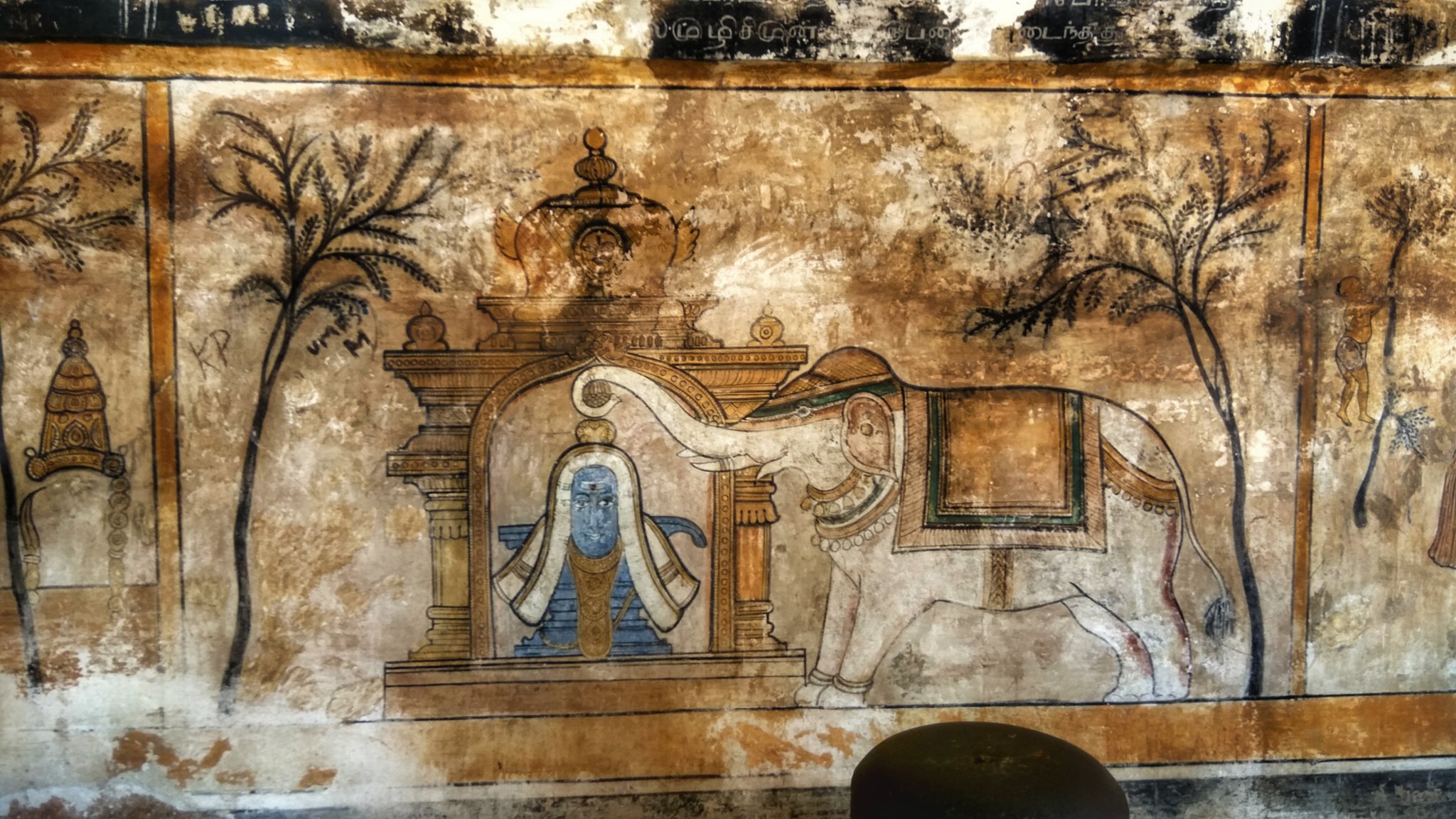 |
| Pushpadanta |
Another mural painting of Uma-Maheshwara showing a Chola couple seeking their blessings
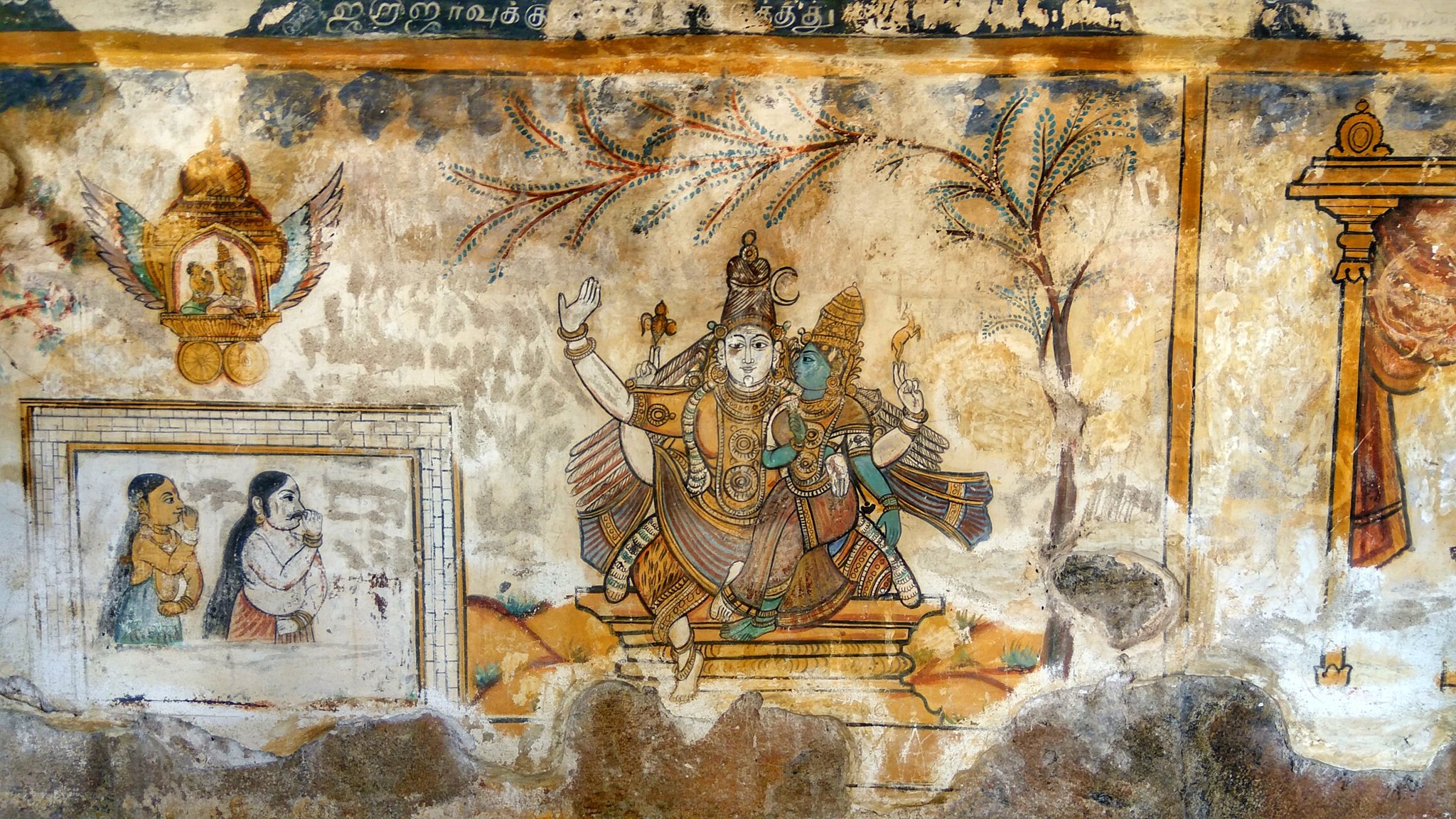 |
| Uma Maheswara |
Lord Shiva as Nataraja with Apasamara at his feet.
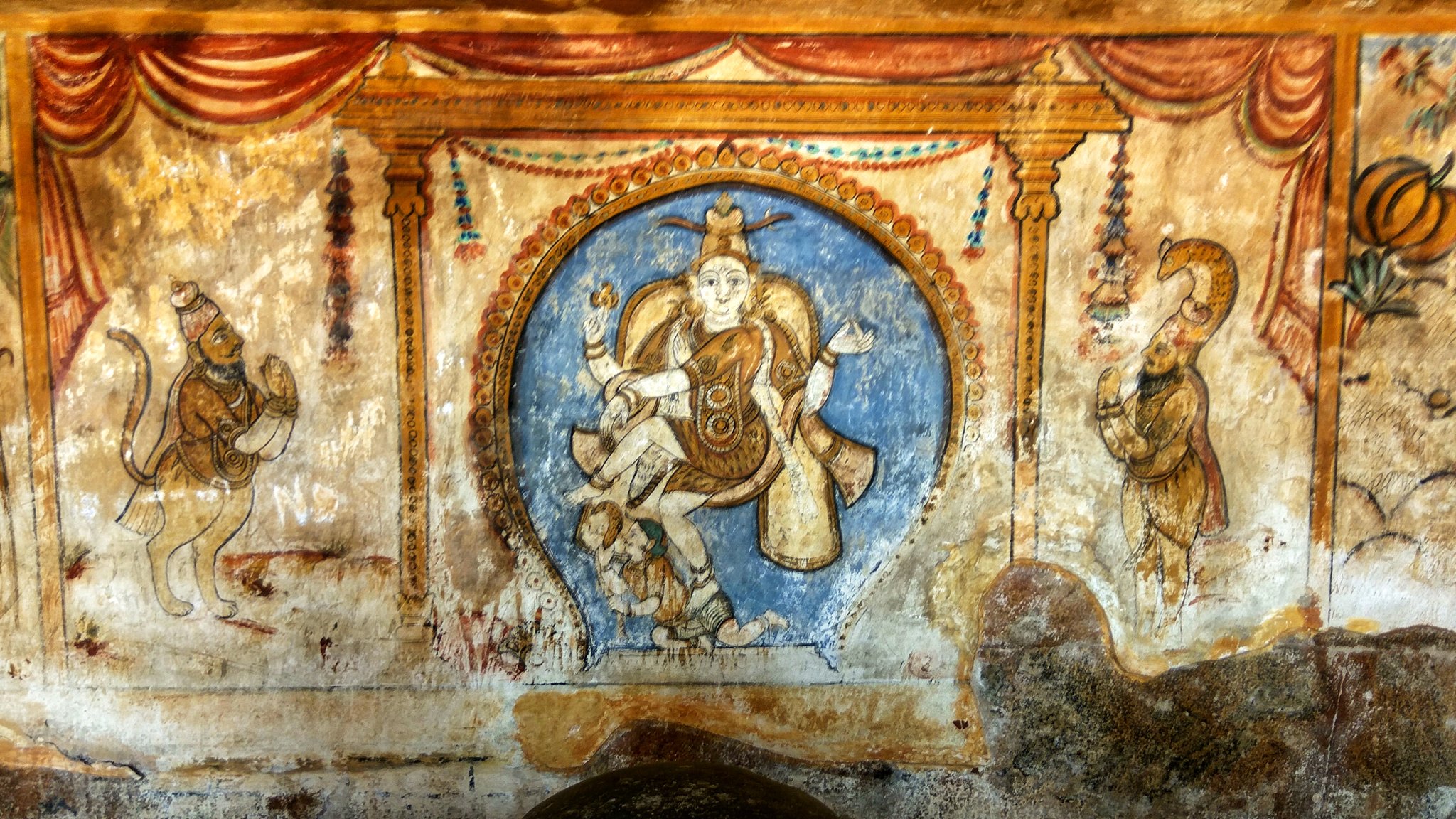 |
| Nataraja |
The below mural shows Goddess Meenakshi Amman emerging out of Agni. On the right side are her parents Maharaja Malayadhwajan & Queen Kanchanamala.
 |
| Meenakshi Amman |
This painting often mistaken as Yashodha feeding Krishna actually depicts Goddess Parvathi feeding the great Nayanar; Sambandar as a child. There is a whole temple dedicated to this story at Sirkazhi, not far from Thanjavur. Sambamdar is responsible for reviving Shaivism in TN.
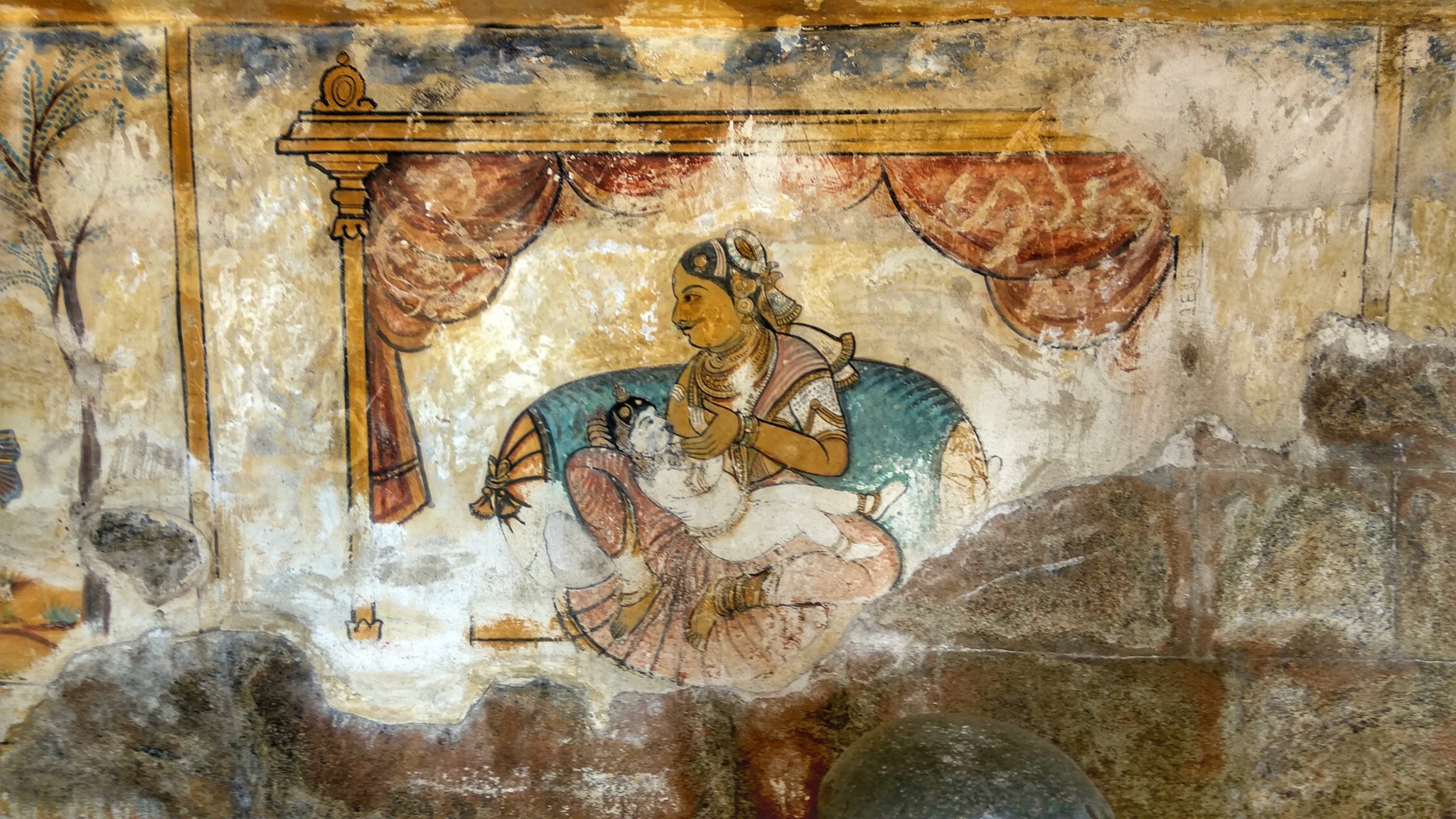 |
| Parvathi feeding the child Thirugnana Sambandar |
Yet another mural depicting Uma-Maheshwara.
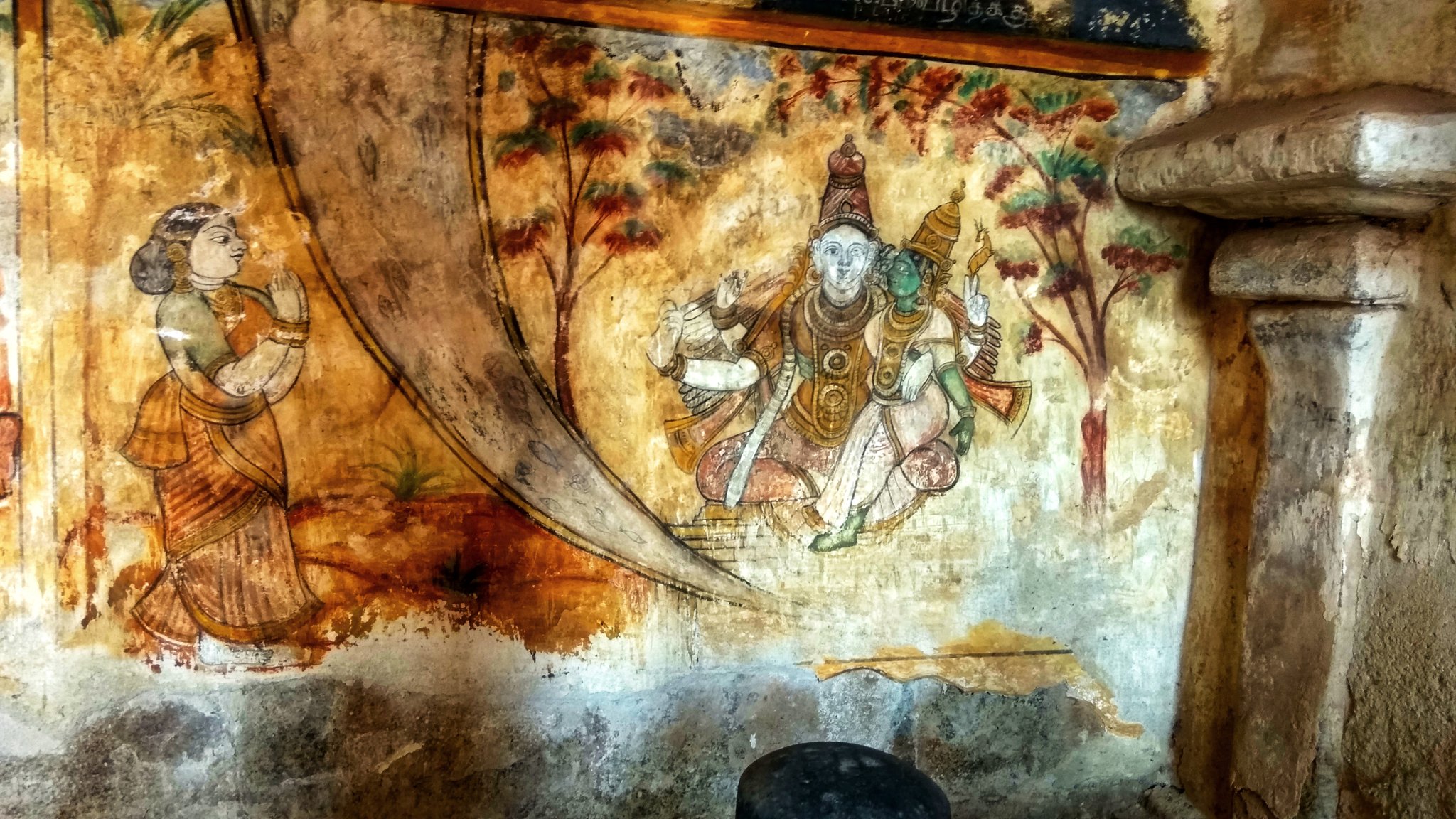 |
| Uma Maheshwara |
A mural of the King of the Devas, Lord Indra worshiping the Shiva Lingam
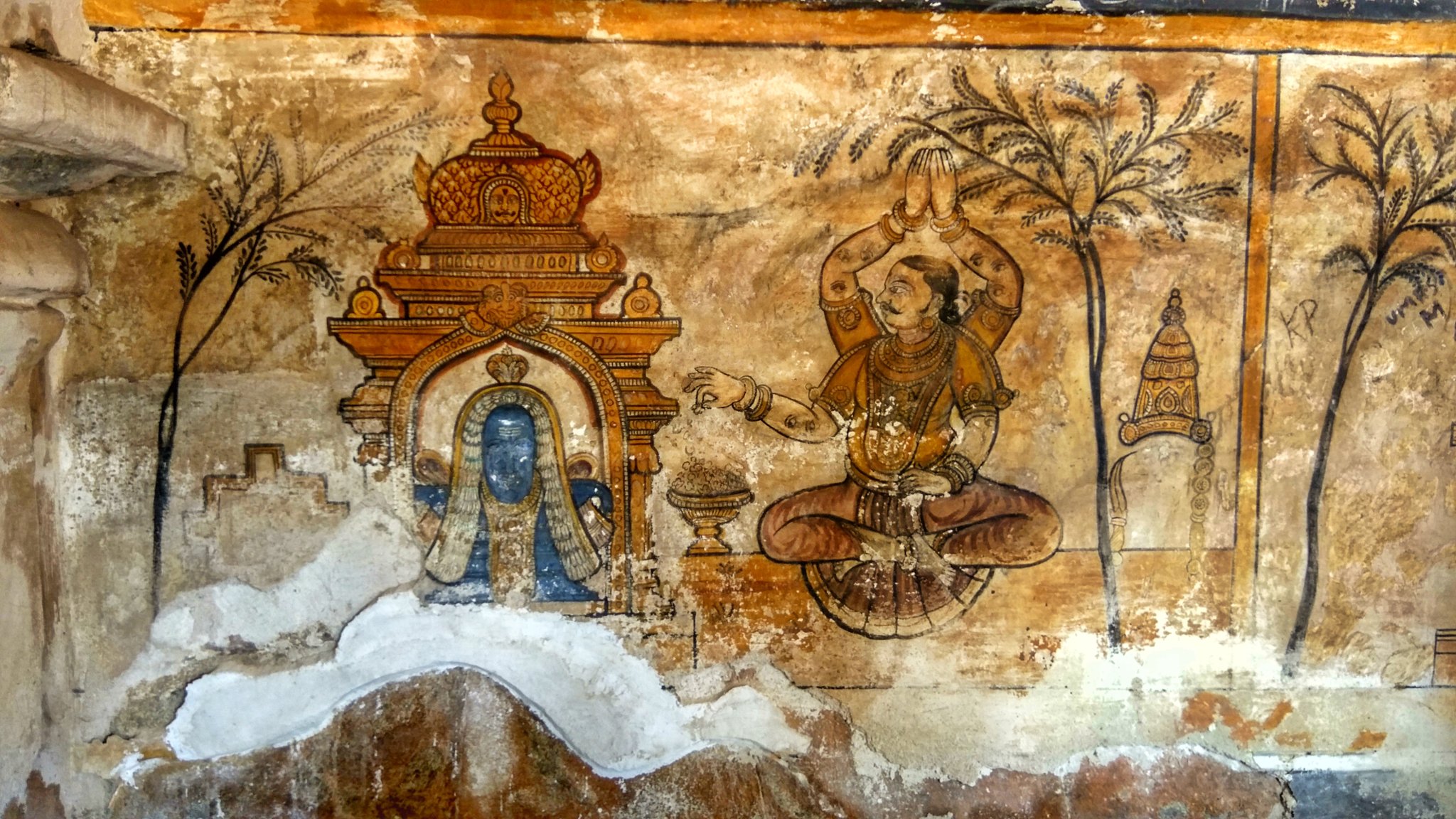 |
| Indra praying to Shiva |
Chola couple seeking the blessings of Lord Shiva
 |
| Lord Shiva |
Lord Shiva as Kalasamharamurthy also known as Kalantaka, seen here dancing in fury on Yamadharmaraja. This aspect of Lord Shiva depicts him as the ultimate one, the conqueror of time & death. He manifests in this form to save his great bhaktha, Markandeya from Lord Yama.
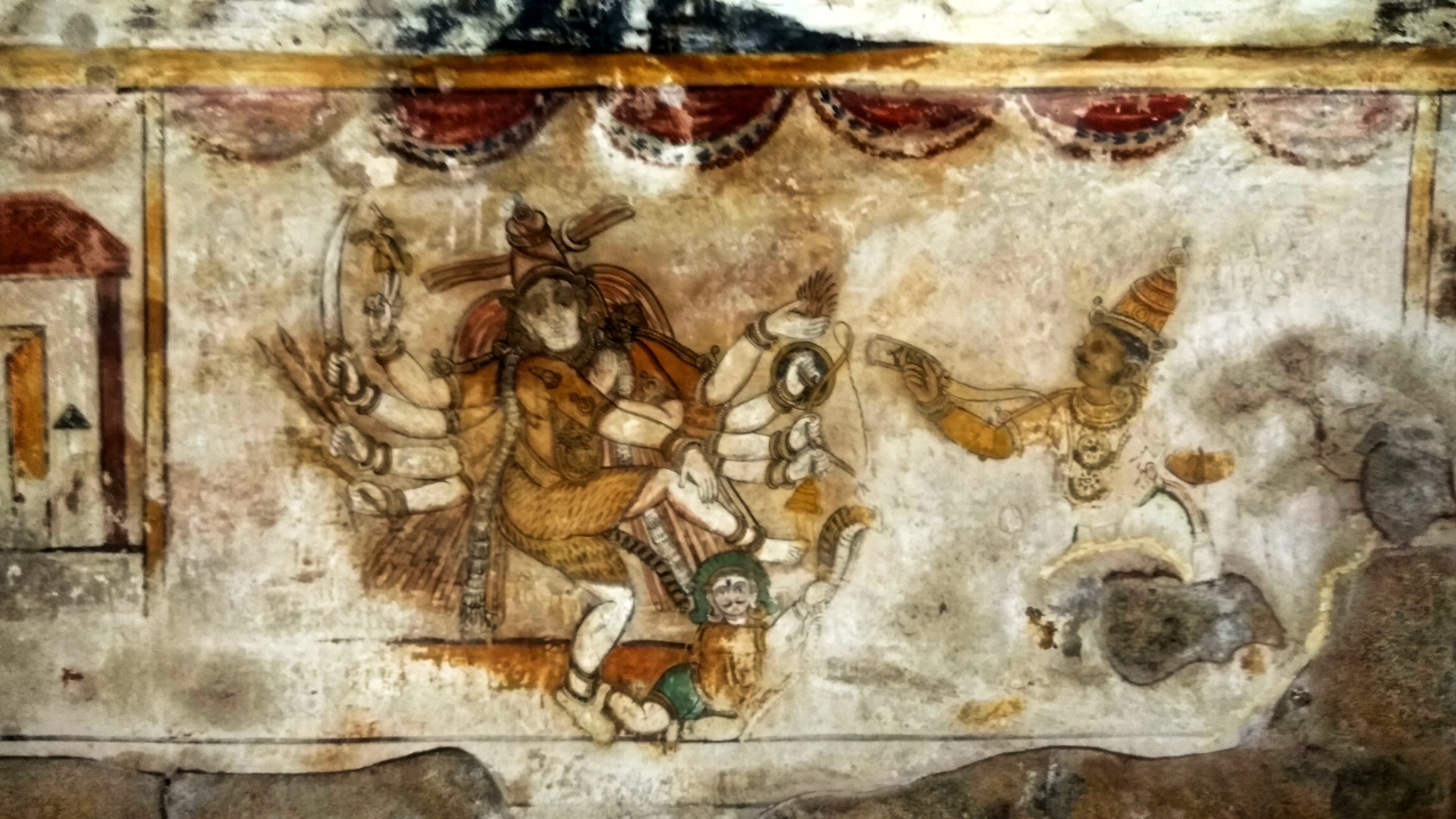 |
| Kalasamharamurthy |
A highly faded mural of Chola subjects seeking the blessings of Goddess Parvati & Lord Shiva. Notice the galloping deer on Lord Shiva's extended left rear arm.
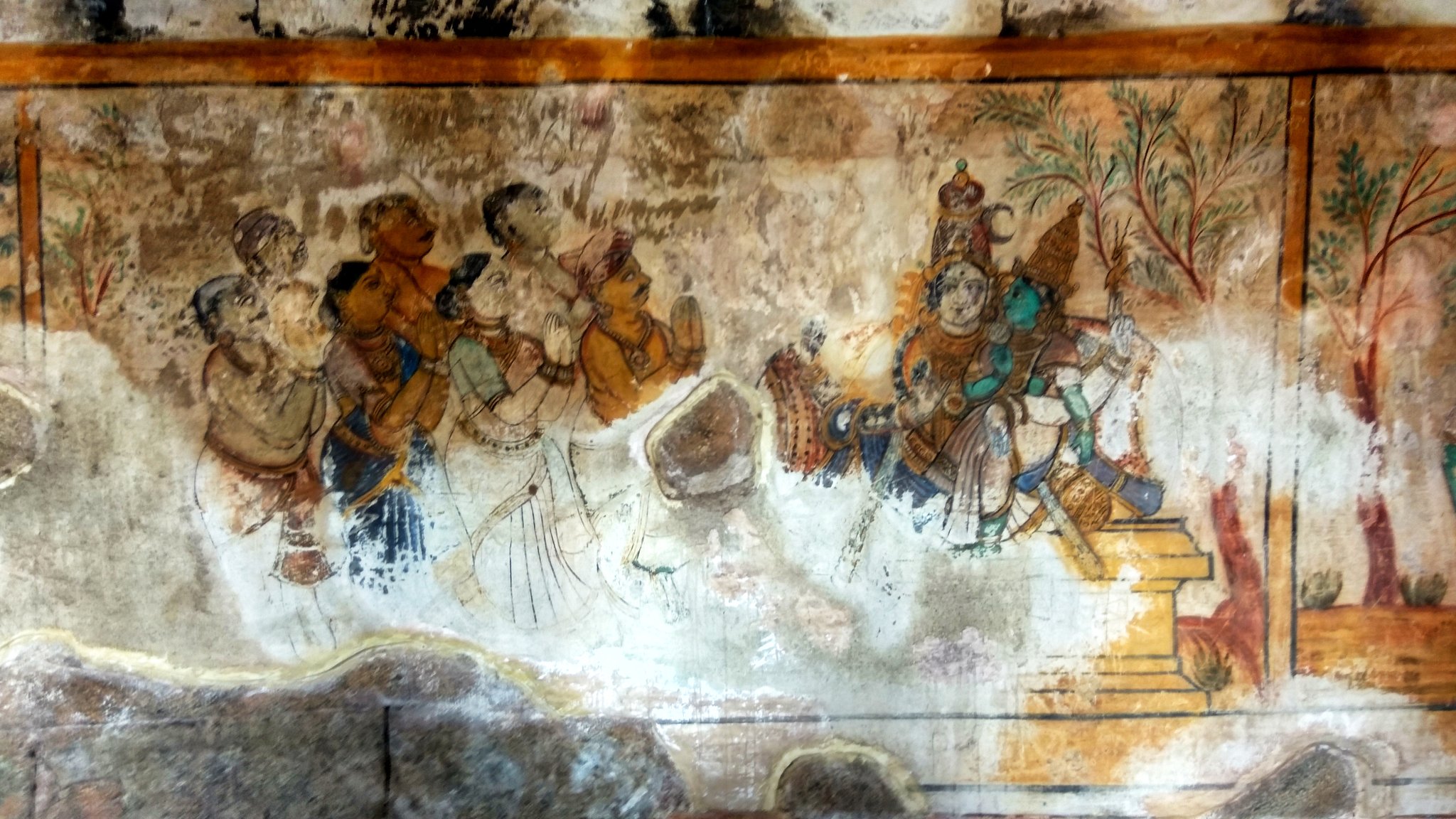 |
| Parvathi & Shiva |
More mural paintings. It was during the reign of King Vijaya Raghava Nayaka in the mid 16th century that the restoration of the paintings were undertaken at the temple. While restoring existing centuries old Chola art, the Nayakas also added their own unique touch to the Murals.
The then Maratha king of Thanjavur, Maharaj Serfoji Bhonsle, a great patron of art & culture performed the sthapana of these 108 Lingams in the late 17th century. He also renovated numerous Chola era temples in the Kaveri delta region.
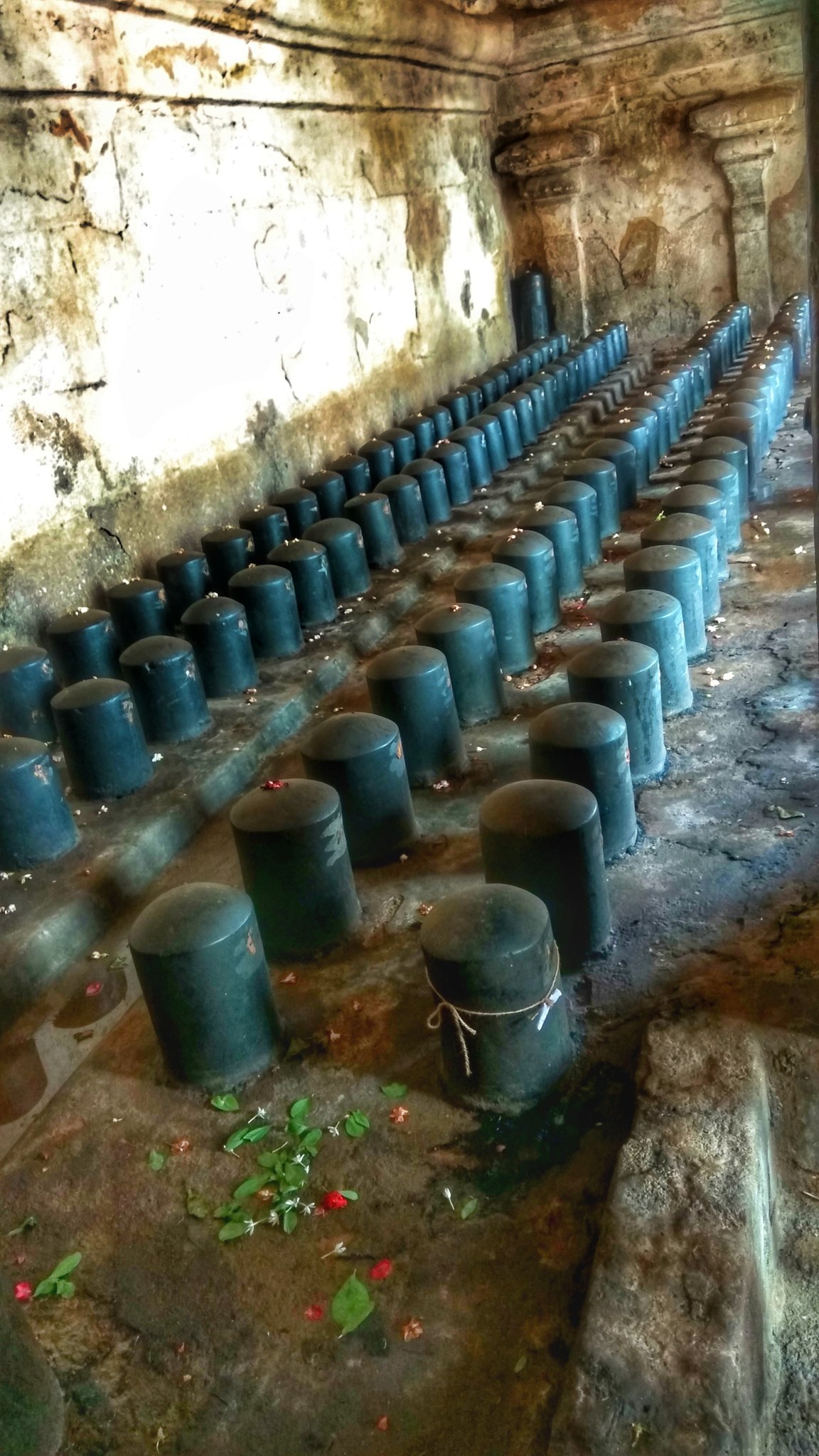 |
| Lingams installed by Serfoji |
This is Lord Subramanya's gudi situated in the North-West corner of the Temple complex. Seen in the background is the Sri Vimana & the Vimana of Subramanya gudi.
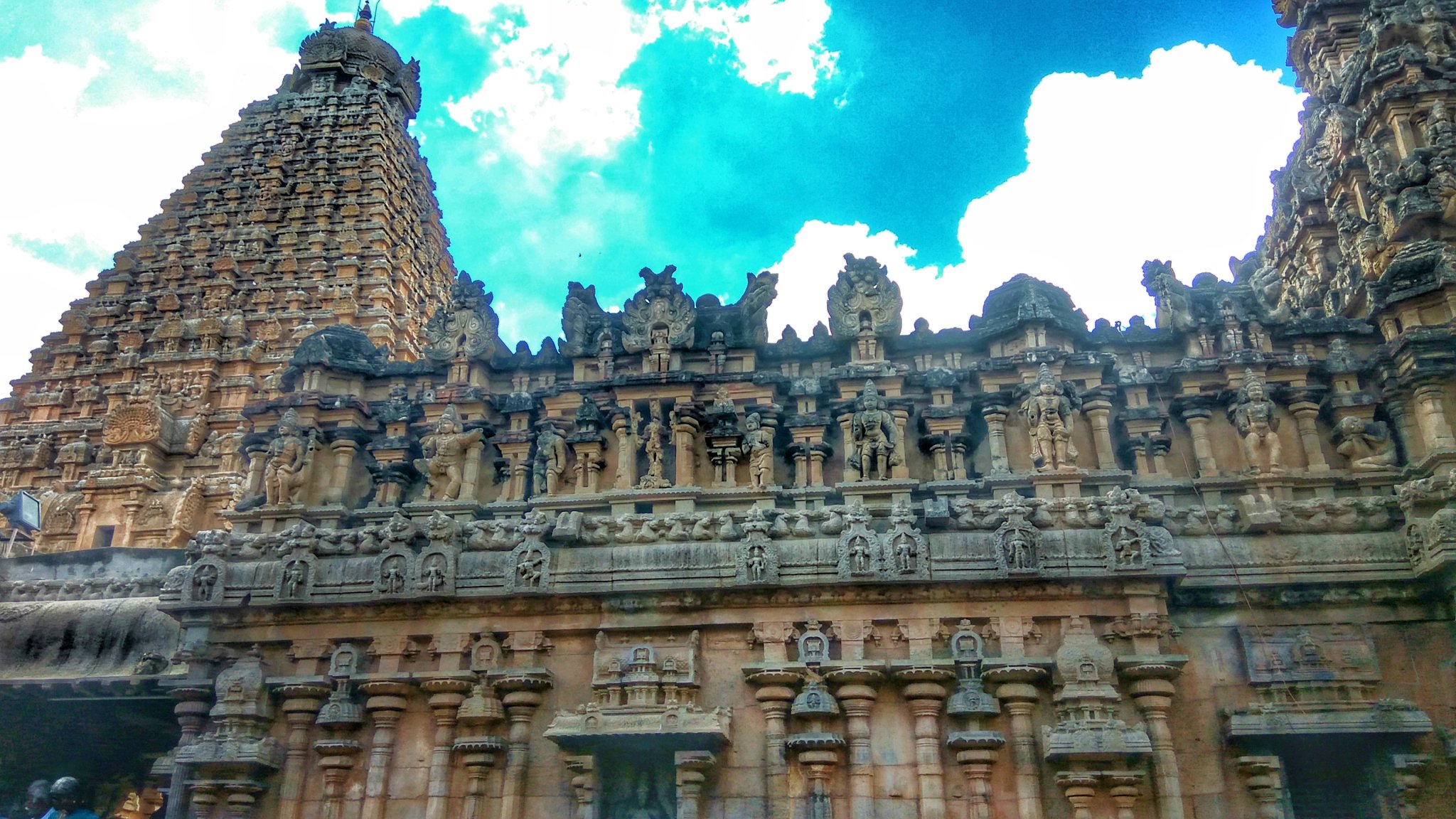 |
| Subramanya shrine |
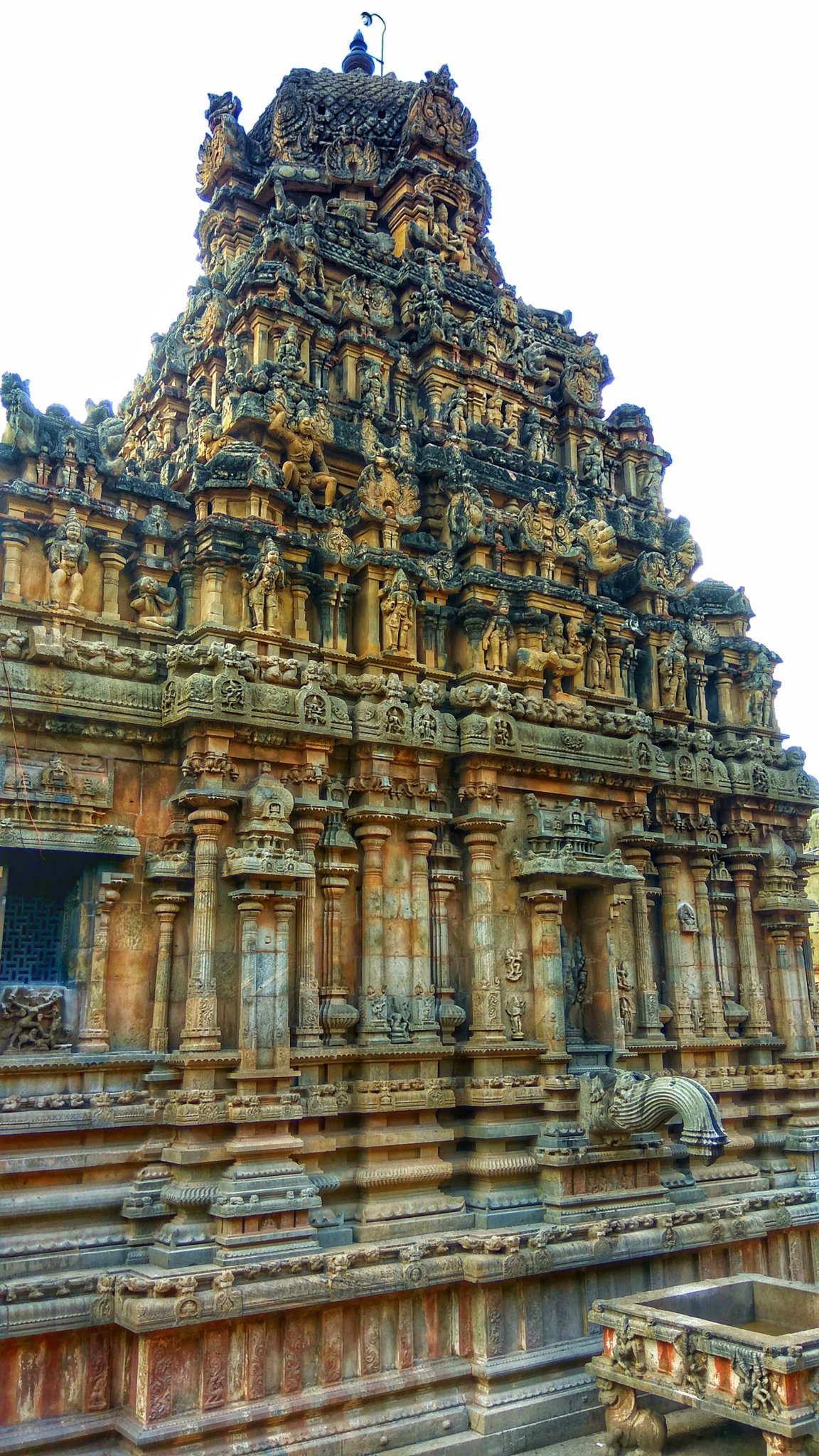 |
| Subramanya shrine Vimana |
Like all Shiva temples there is a seperate gudi for Chandeshwara in the north. He is one of the 63 Nayanars & the main guardian of temple wealth. The Sri Vimana dwarfs this shrine.
 |
| Chandeshwara shrine |
Bhaktas after performing pradikshanam (parikrama) to Lord Shiva come to the Chandeshwara gudi & make some kind of noise, like snapping of fingers or a clap to wake him from deep meditative state to infrom him that they are leaving the temple empty handed.
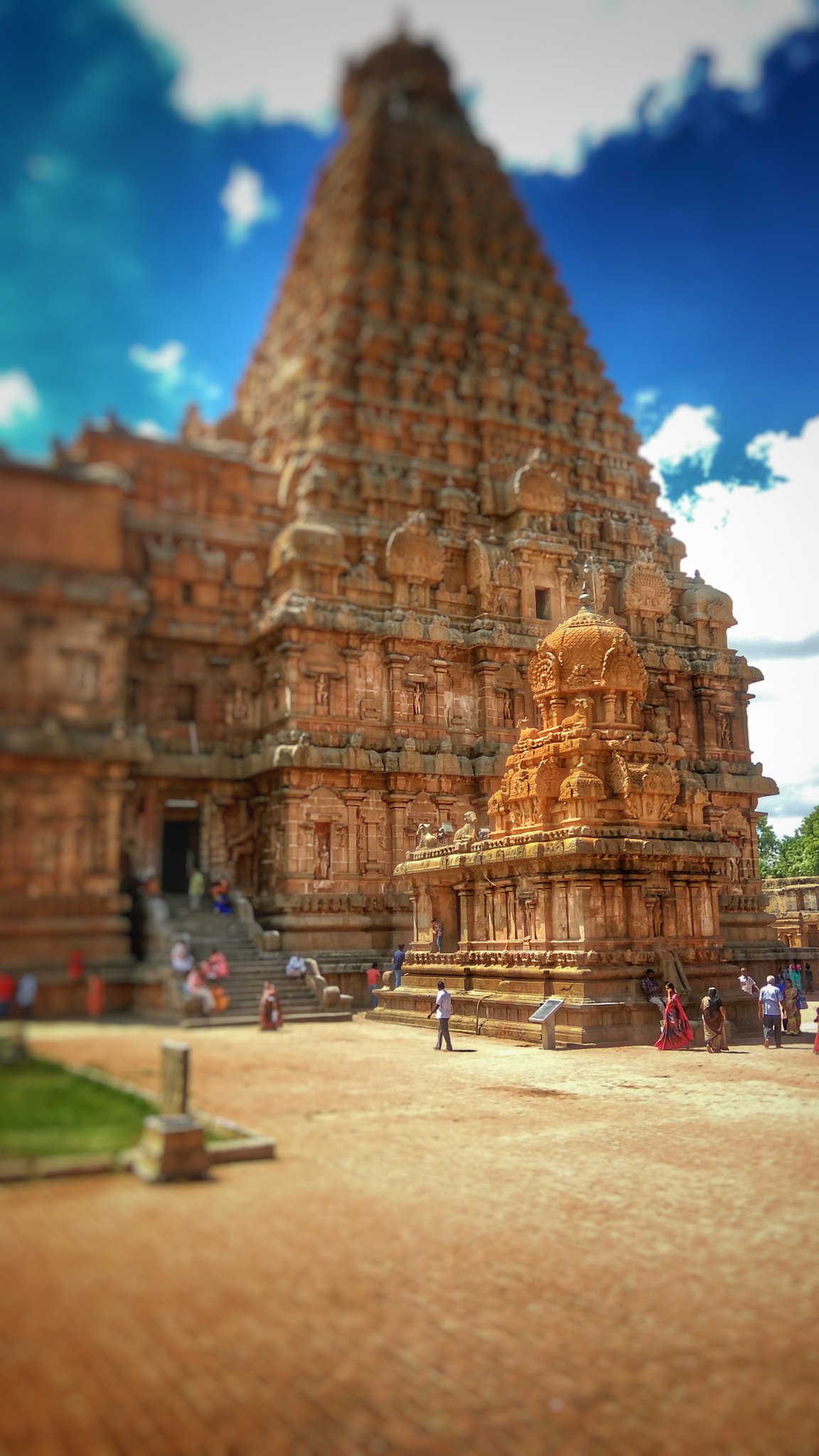 |
| Chandeshwara gudi |
The focus of this particular post on The Brihadeeswara Temple at Thanjavur was on mainly the mural paintings. I have written another detailed post focusing on sculptures from another Chola Temple,
The Airavateswara Temple At Darasuram
Though I've been to these 3 Temples on several occasions, I find myself learning something new & exciting everytime. I'll conclude this post with pictures of the Vimanas at Thanjavur, Gangaikonda Cholapuram & Darasuram respectively. Thank you for reading.
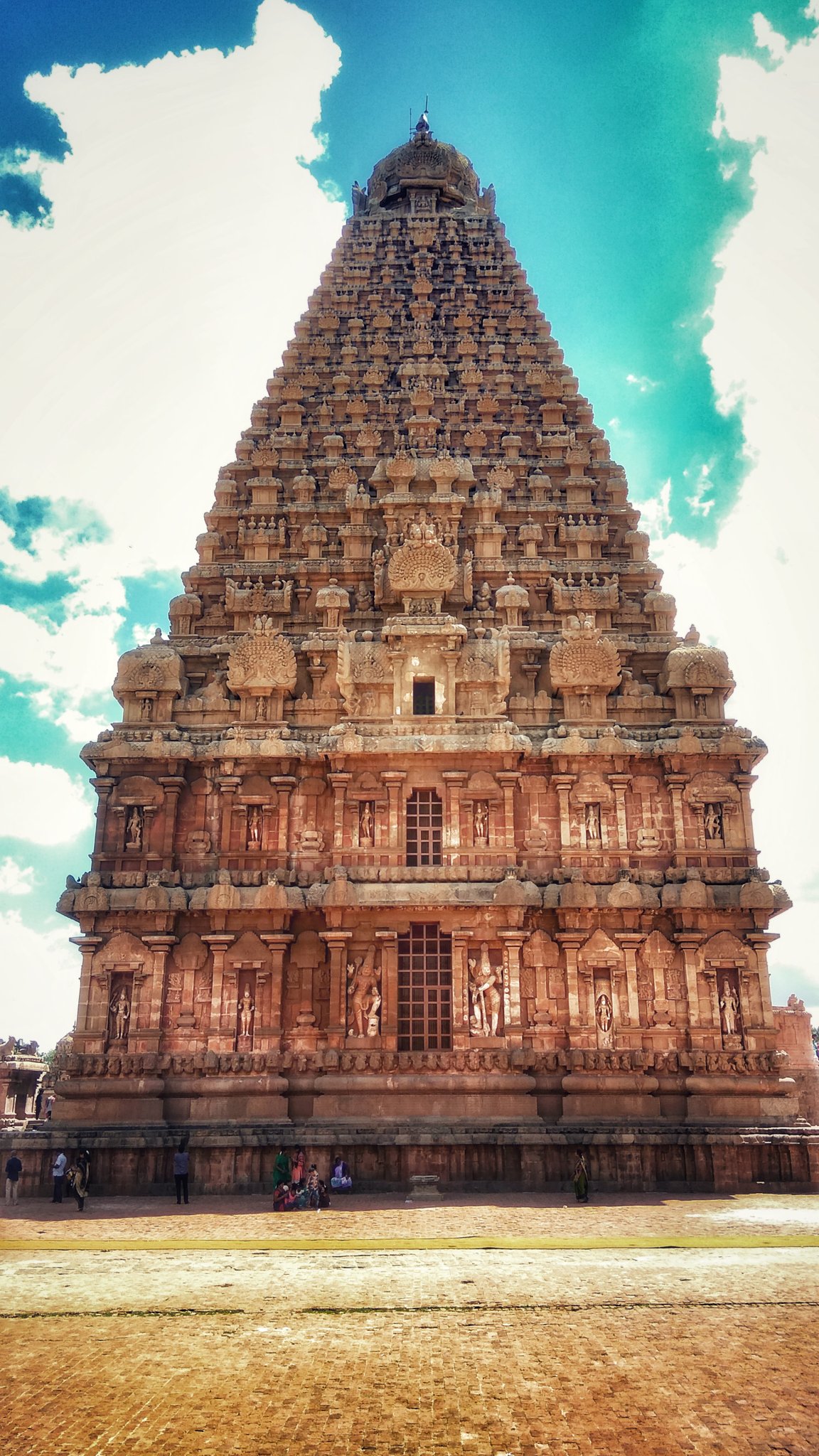 |
| Thanjavur |
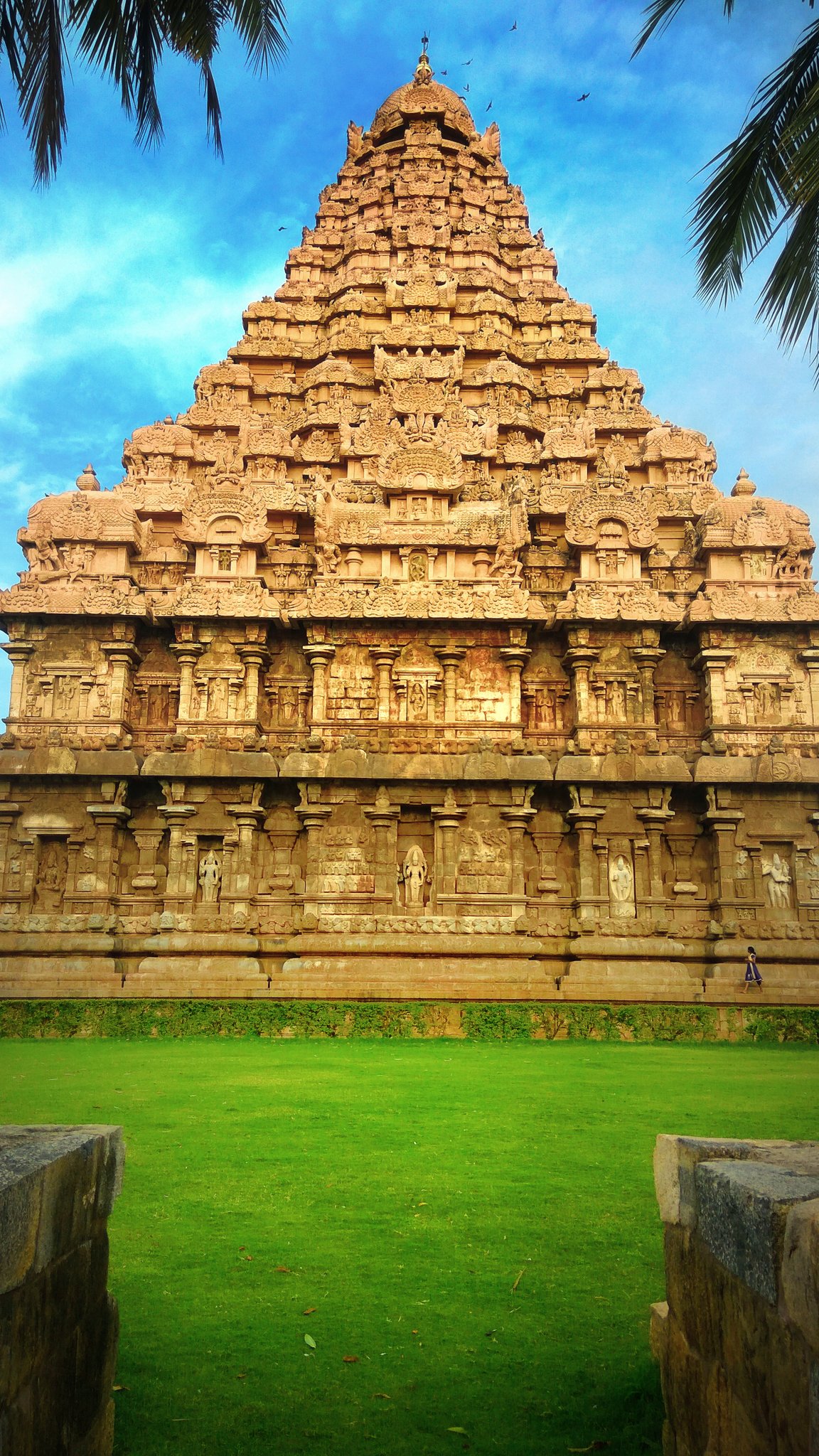 |
| Gangaikonda Cholapuram |
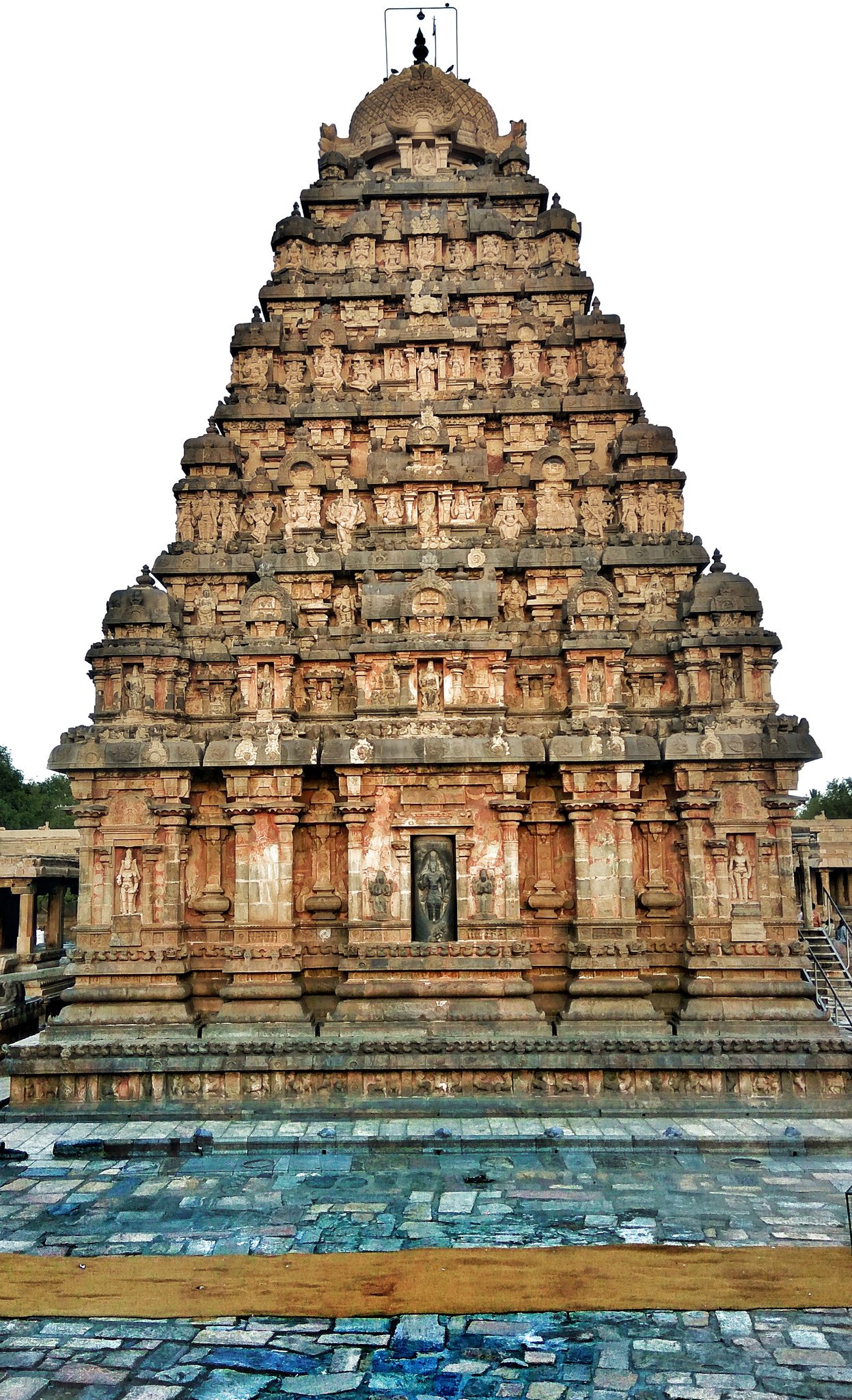 |
| Darasuram |

